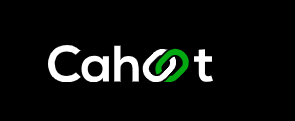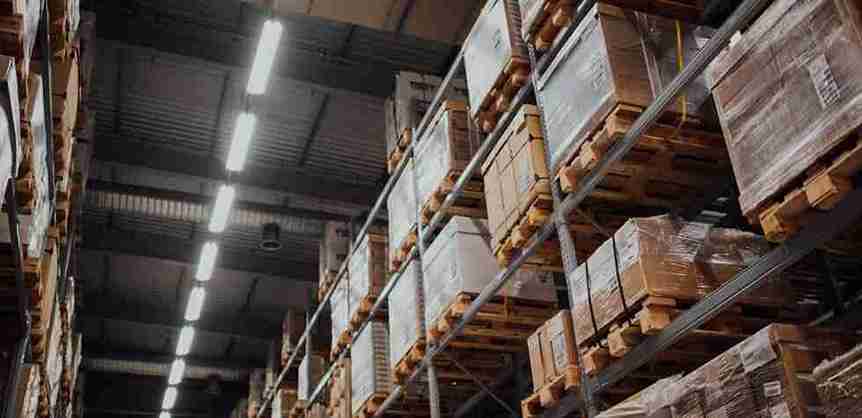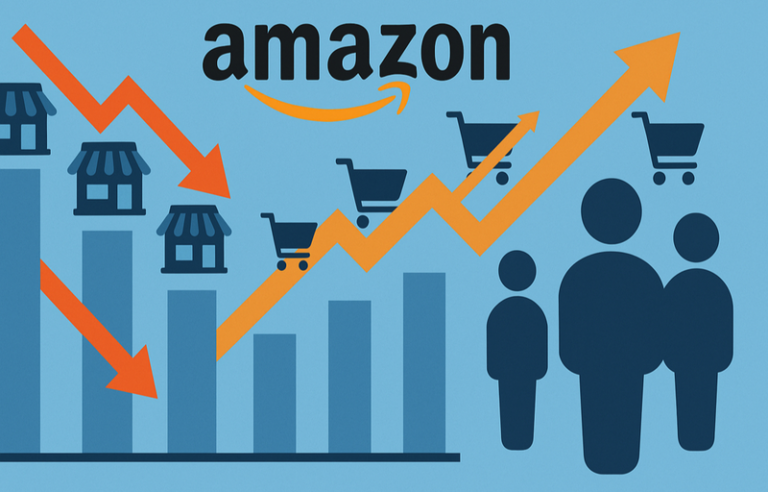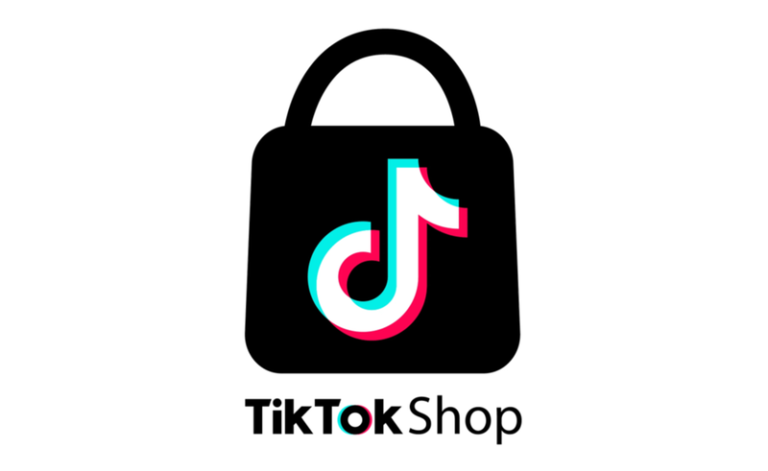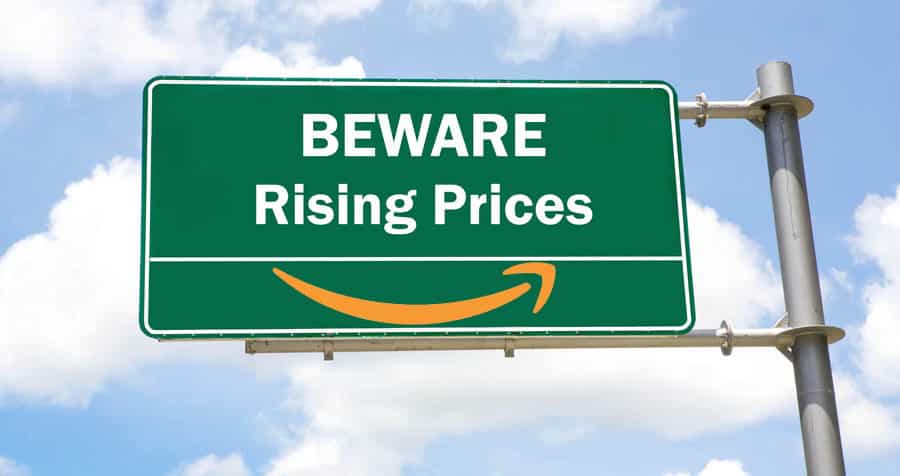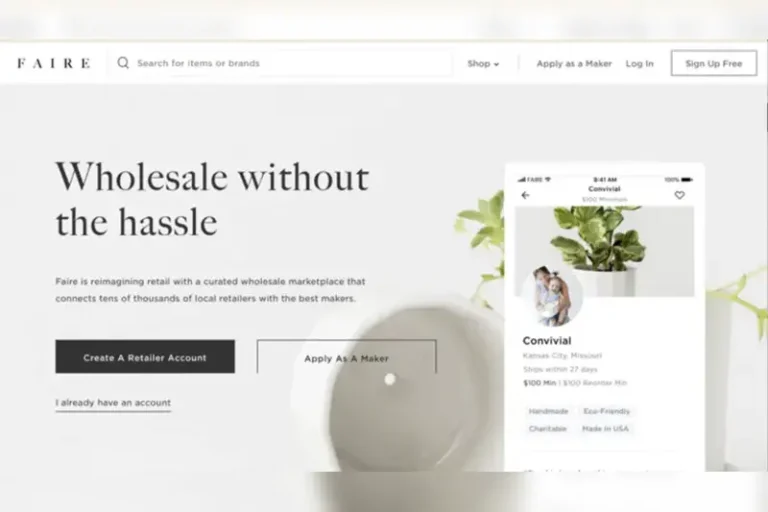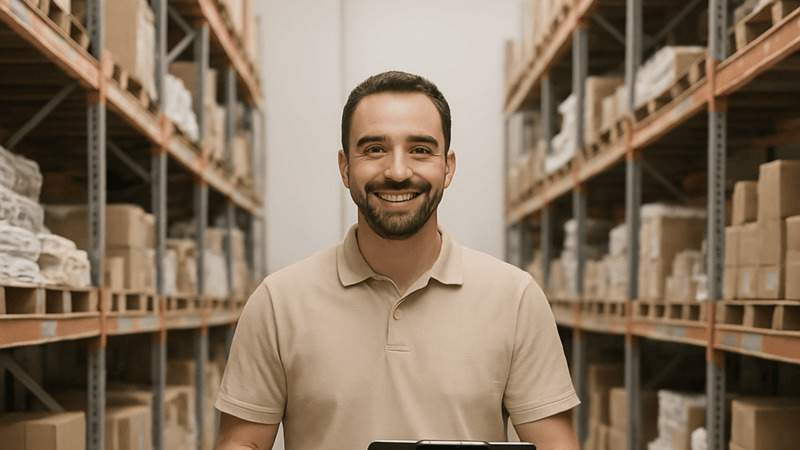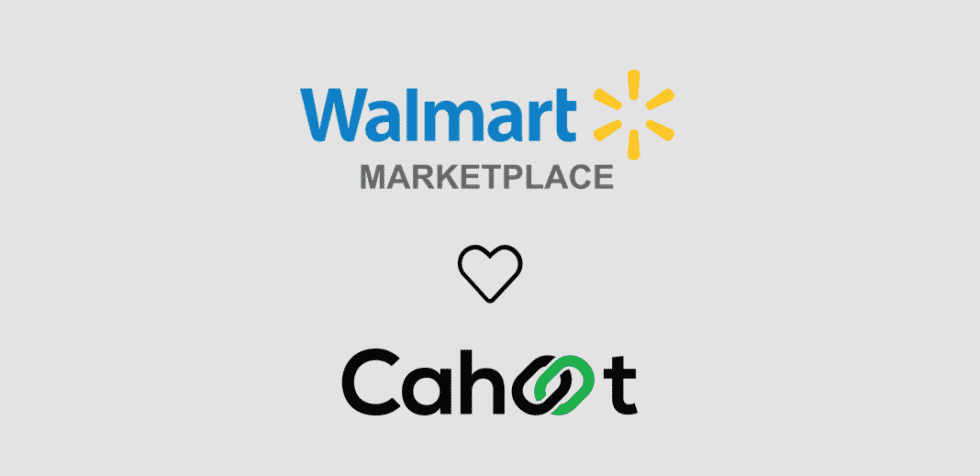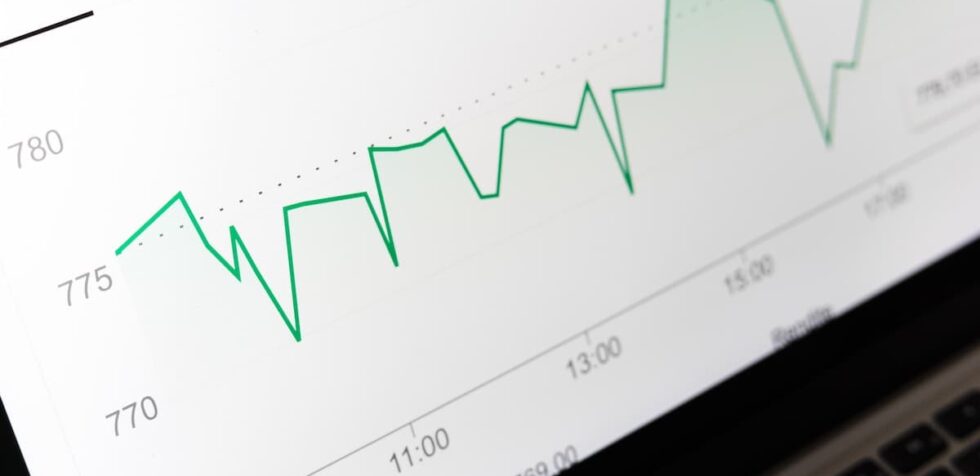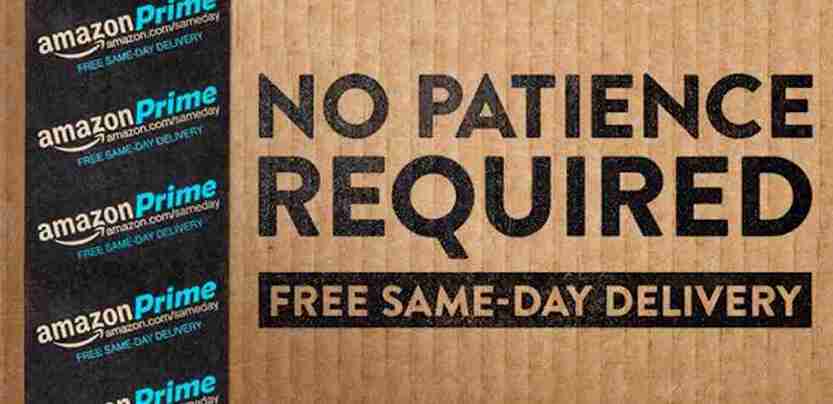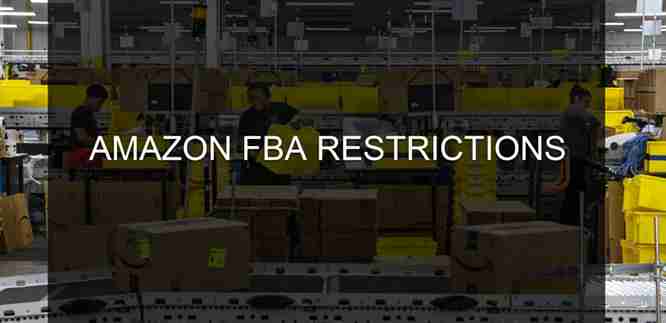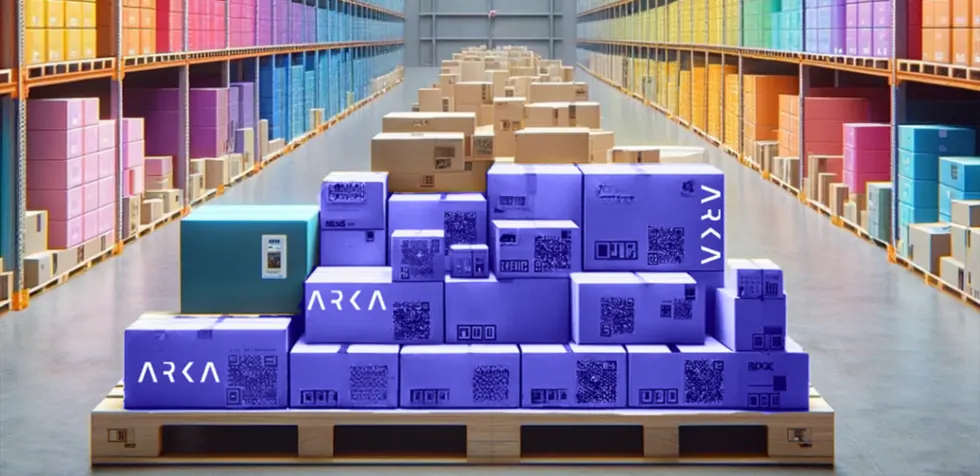Overcoming Amazon’s Inventory Limits: Order Fulfillment Alternative
In this article
 22 minutes
22 minutes
Listen to podcast here.
Podcast Episode 185 – Avoiding FBA Limits with an Alternative Order Fulfillment Network with Cahoot
The Smartest Amazon Seller Podcast discussed the issue of warehouse inventory limits, which is becoming a major challenge for all Amazon sellers. Amazon’s warehouse inventory limits are getting lower as Q4 ramps up, leading to difficulty for sellers to send everything into FBA – Fulfilled By Amazon. The problem is exacerbated by Amazon’s challenge in hiring order fulfillment workers across its warehouses. The podcast host, Scott Needham, invited Manish from Cahoot to discuss an alternative solution. Cahoot is a company that has created a peer-to-peer network for order fulfillment, allowing sellers to use its warehouses to store their products and deliver them to customers. Cahoot was first trying to do a co-mingled Fulfilled By Merchant (FBM) solution, but has now pivoted to an order fulfillment services network. Its order fulfillment services are intended to create efficiency, reduce order shipping costs and transit time, and make it easy for sellers to operate in a highly profit-challenged environment. The podcast discussed how Cahoot’s order fulfillment service can help sellers overcome the problem of Amazon’s strict inventory limits.
Scott Needham:
Welcome to the Smartest Amazon Seller Podcast, your host, Scott Needham. I am an Amazon seller for 10 years, and in my 10th year, I’m actually literally about to wrap up, hit 10 years. Something has happened again, that’s become an issue for all Amazon sellers, that if you’re really paying attention, inventory limits are, they’re getting lower as Q4 ramps up, which is kind of, it’s the opposite of what we want. Usually you want your limits to go up when you, because right now you want to spend all your money to buy inventory to bulk up for the next eight weeks. I’m recording this right before November. So a lot of people are getting challenged. They can’t send everything into FBA, and if you don’t have an alternative solution, you’re kind of stuck. So I’ve got with me someone that has an alternative solution that I actually think is quite scalable. I’ve got Manish from Cahoot. Manish, welcome.
Manish:
Scott, thank you for having me.
Scott Needham:
So let’s just chat through this. If we’re talking big picture, how I see things, Amazon, because of COVID and 2021 and 2020, they increase their capacity considerably. Actually, I’m seeing reports that they increased it too much, but they also have a different problem. If you increase your capacity, they also have to have employees to do that, and they have hired hundreds of thousands of people, but they’ve also had huge turnover, lots of turnover. So much that they do have a business challenge in that they are exhausting the number of people that are available for employment across some of the warehouses that they serve in different markets. So that leads me to think, inventory limits, they’re going to be around. It’s going to be cyclical. Who knows? We’re fighting against market forces, bigger market forces. Are there a hundred thousand people that can work in this capacity in this market? And that’s either a yes or no, and if not, then they can’t receive everything. So that’s how I would set the stage. And why, again, a year after the worst of these inventory limits, we’re seeing this again. How do you see this?
Manish:
Well, that’s a great question, Scott. And you said it right. Half of Americans of the available workforce has either applied or worked at Amazon or has worked and quit at Amazon. So Amazon is running out of order fulfillment workers to hire, and that’s no secret. I mean, everybody knows that. So you have a bit of a dichotomy. On one hand, two quarters ago, Amazon came out and blamed their excess build, they actually added more warehouses in 2020 and 2021 than they had done in the previous 18 years of their operation. So they went all in, and then of course they came back and they said, “Oh, we made less money because we overbuilt. We have tons of excess capacity. We’re going to go rent out or sublease, hundred million or so square feet of space.”
And then you as a seller, and many others that I speak with regularly, are complaining that their stock limits are down. So it’s highly confusing for the seller because they’re getting news from both sides of their mouth, and that’s not… So the reality is, what we believe and suspect, that while the facilities might have been built, they are not online. So you could count them as overbuilding, but they’re not enough. They’re not online. They don’t have enough order fulfillment workers to make those facilities work. And that’s why the sellers are continually facing strict inventory limits at FBA. So it’s a real problem.
Scott Needham:
I’ve got two selling businesses that I check in on every day. One of them does have limits, and the other one actually has the opposite of the problem, has actually more space than we need. So it affects people at different sizes in different ways. And every business model is slightly different. And some people can transition to FBM on their own and some people can’t. Just like I do think one of the benefits of E-commerce is you can work out of your house and you don’t have to ever touch inventory if you are using, if you’re being creative, if you’re aware of either prep centers or 3PLs, whatever.
I’ve been aware of Cahoot for a while, and if I get anything wrong about your background, but you guys have slightly pivoted in that Cahoot was first trying to do a co-mingled FBM solution. Where if I was selling Head & Shoulders shampoo and I had it in my warehouse, in my backyard in Utah, but the customer was in New Jersey, if someone else had that same product, that same skew in New Jersey, they could satisfy the customer for about half the price. And now you created this peer-to-peer network for order fulfillment. And that’s a really creative and interesting solution, kind of a hard problem to solve because of all the different variables. But that’s how Cahoot started, right?
Manish:
Yes, we are… We’ve been fanatically focused on optimization. And the idea is how do you reduce the shipping costs, the transit time, and make it easy for sellers to operate in a highly profit challenged environment? So all our solutions are intended to create efficiency. And yes, you’re right about our history.
Scott Needham:
You had to create a lot of tech, tech that you actually still use, but you guys now lean in a little bit more to an order fulfillment services network. So basically an alternative to FBA. And if say someone wants to sell 10,000 units of Head & Shoulders shampoo, they get to utilize your network as opposed to FBA. And I actually think there’s a few cool things that we’re going to talk about with the Cahoot network that are kind of different, never heard of before. And I was like, “Okay, this is a worthwhile conversation and worth exploring.”
Manish:
Absolutely. I mean, sellers can, we believe in supporting the sellers wherever they sell. Cahoot takes a full service approach to fulfillment. So we support, if the merchants want to send some inventory to FBA, we also support the highest standard in fulfillment, which is Seller Fulfilled Prime (SFP). Which is very, very hard to find a solution for because of the extremely stringent metrics. So if you are listening, and if you’re a seller that has Seller Fulfilled Prime (SFP), you should hang onto it.
And if you wanted to do FBM and if you were affected by FBA restock limits or you are unhappy with the receiving delays, which we know there’s a long receiving delay at FBA, or other challenges. Like returns, so that’s a big problem because your return rate is 20% generally higher with FBA than FBM or if you’re selling on other marketplaces and channels, whether Shopify, your website, on Walmart, eBay, other places, because every seller ought to be selling on multiple channels. So you can come to Cahoot and Cahoot can provide an Amazon FBA like service, and it’s an alternative to FBA so that you can continue selling regardless of whether you can get your inventory into FBA or not.
Scott Needham:
I mean, Seller Fulfilled Prime (SFP), it’s tough. I’ve done it, seen it work out, seen us get kicked off a few times as you need to get stuff out the door fast. So right now people need space, they need alternatives to FBA. And you guys, very straightforward, kind of offer your network. And you could even make some comparison to an Uber model for shipping and FBM and so much that you actually have some sellers that join the network and make their warehouse available, whether it’s space-
Manish:
That’s right.
Scott Needham:
And fulfillment.
Manish:
Right. That’s right. I mean, what’s unique about Cahoot is it’s a peer-to-peer network. So essentially it’s a peer-to-peer collaboration platform. So on one side of our network, the demand side, which is ecommerce brands and retailers that are looking for affordable fulfillment services, akin to if you were looking to outsource your fulfillment, some are part of it. So we would support that and we would place our client’s inventory at one or more warehouses in the Cahoot network. And Cahoot provides a very, a technologically advanced solution. So we connect directly with the sales channels, we have deep integrations with every popular channel out there. And then we provide a very simple pricing to our clients so that they don’t have to deal with the complexities of, “Hey, what’s the SLA in California? And what’s the storage fees at California versus New York or versus Miami?” Or what have you.
Because sellers are looking for simplicity, they’re looking for predictability, and they’re looking for one throat to choke, so as to speak, when it comes to holding people accountable. And that’s what Cahoot provides. And that’s the only reason why Cahoot is able to achieve Amazon Seller Fulfilled Prime (SFP) metrics, which is frankly very difficult to achieve through traditional 3PLs. So that’s a demand side of our network. And on the supply side, these are warehouses that belong to other ecommerce brands and retailers that have excess capacity in their warehouse. So right now, if you are running your own warehouse and you’ve got five, 10, 20,000 square feet of excess space, it’s literally sitting idle. You’re not making any money. Your rent, your mortgage, your utilities are the same. So you have the opportunity for the very first time to join the order fulfillment services network and make some extra cash.
Scott Needham:
Yeah. I’ve definitely had a facility where we’ve had tens of thousands of square feet and I’m like, if you push us, yeah, we could actually set aside 10,000 and utilize the space better. And especially… Certain parts of the season, there’s always more ways to utilize space better. We’re not always great at that. But if there’s an economic incentive, like what you guys have, to be able to rent some of the space, basically take your rental costs down, that’s very interesting. And obviously there’s some areas of the country that are just more in demand, California and the northeast coast, because that’s where most ships are coming in. So that’s really interesting. And I like seeing what solutions work for some people. People ask me frequently, and sometimes there’s just always trade-offs. What would you describe, how expensive is it to fulfill Seller Fulfilled Prime (SFP) through your network? Because I think people still want the Prime badge, but they don’t want to, we can’t pay $30 for every single shipment.
Manish:
No, nobody does, Scott. I think that is not a economically viable solution for vast majority of the sellers. So what Cahoot does is, you’re utilizing the economy ground shipping to ship the items and still meet that one-day, two-day delivery requirements of Seller Fulfilled Prime (SFP).
Scott Needham:
Is that because you guys are, because you’re distributing the inventory across the network?
Manish:
That’s right. In order to achieve two-day delivery target, Scott, you need at least four to five strategically placed warehouses. And in order to achieve one-day delivery target using economy ground like a UPS ground or FedEx ground, you need nine locations. And so what Cahoot does is places the inventory based on the demographic of your customers so that we can continue, one, meeting the SFP metrics that is needed in order to protect your account. And number two, do it affordably using the ground service. So you actually pay less than you would pay from your single warehouse.
Scott Needham:
Do you have sellers split up the shipment? Obviously that happens at the beginning, but do you ever do any transshipping yourselves or is that kind of like you’d rather replenish through having the seller replenish one at a time?
Manish:
I mean, both options are available on the Cahoot network. So essentially sellers can ship directly to the warehouses that they have been assigned based on the data. So we are very, very data driven. So that’s how we are able to minimize cost. Or in many cases, we would have a hub location that would act as your primary reservoir for inventory, and then we would trickle in the inventory across the nation as the demand warrants. So it’s the model behind the scenes is not fundamentally much different than how Amazon runs its own FBA network.
Scott Needham:
Yeah, that sounds exactly like that. You must have some pretty big warehouses.
Manish:
We have large and small because Cahoot was always designed to level the playing field. So if you had a warehouse that had 10,000 square feet, we don’t want to exclude that because there is power in numbers. There is a power in working with entrepreneurs, and some of them are absolutely top-notch. I mean, they do phenomenal job. And that’s probably the reason, or one of the very important reasons why Cahoot is able to offer the industry’s highest order fulfillment standards at a lower cost.
Scott Needham:
You know what? You make me feel like the world is just bigger. I just keep learning and just figuring out there’s this whole network going on and I haven’t even been… Keenly aware of it. I don’t know. It means there’s a ton of sellers that need this and then there’s a ton of warehouses that can meet Seller Fulfilled Prime (SFP). That’s not easy. And to make that, to get, like you said, nine different locations across the US and this was happen-
Manish:
It may look daunting to others, but it is business as usual at Cahoot. This is what we do, and we have been doing this for several years and we are the best in class when it comes to that level of accountability. Because I think there’s another big development that you may or may not be familiar with, Scott, is this Amazon Buy with Prime. So this concept of Seller Fulfilled Prime (SFP) is coming to every channel. And if your sellers are not aware, the audience is not aware, I’ve got a really awesome presentation on Buy with Prime and how that is going to affect the consumer expectation on every channel because this whole Seller Fulfilled Prime (SFP), or Prime-like delivery is going to be expected on every channel, on and off Amazon. And there’s a whole presentation, if people are interested, they can check it out on our resource library at www.cahoot.ai.
Scott Needham:
Interesting. So I mean, obviously some of your clients are multichannel, not just Amazon. Sure, there was a few different ways to go with that. What do you think someone that’s brand new, starting out, selling on anywhere, what would their experience be like? This is where I’m actually going to is you talked about accountability and that you, accountability to me means that you kind of need a web portal. You need to be able to see a view of your inventory and receiving and all things that are going on through hopefully what is on your website. Can you run me through that?
Manish:
Yeah, I mean, we have a best in class software. Everything is on the web. So the seller can pretty much access, if you’re familiar, akin to Amazon Seller Central, you know, will log in, you’ll see the movement of your orders. Orders are coming in from all the integrated channels, then your current inventory position at each of the locations where your inventory is currently situated. So you have realtime visibility into that and also realtime visibility into how orders are being picked, packed, and shipped. And additionally, you can also stay on top of the delivery to make sure that the orders are being delivered on time. In fact, we go one step further because we hold the carriers accountable as well. So if the carriers, they miss the SLA or if Cahoot misses the SLA, we like to expose that to our audience, to our sellers. Because for us, it’s a network, which is you are, we are in it together, and therefore it’s very important that we are making that information available so that all parties are holding each other accountable.
Scott Needham:
Love it. That’s awesome. And is there any part of this network? I feel like we’ve covered the very immediate need that a lot of people have. I do think that having an FBM alternative to FBA is good diversity, especially in Q4. What part of what you guys do, do you feel like we haven’t covered yet?
Manish:
Well, one, I think the whole net impact of this innovation is lower cost, higher quality. People think that if you need higher quality, you need to pay more. And Cahoot is turning that on its head that because of this peer-to-peer network, we’re able to lower cost than the traditional options that you may have available. Number two, it’s a myth that FBA is cheaper or cheapest for everything. That is a big myth that is not true. FBA fees have gone up 30% in the last two years, so you should look at your rates today, not two weeks from now, not two months from now. So you would be shocked that FBA is not cheap and certainly not for multichannel fulfillment. So if you’re using FBA to fulfill your website orders or Walmart orders, you should look at that again. And Cahoot is able to offer something very affordable. Besides that, we also have the best in class shipping software, which-
Scott Needham:
Well-
Manish:
So if you have a warehouse… sorry about that.
Scott Needham:
No, you win me over with pricing. Pricing matters. If people were to take a loan, yeah, the interest rate matters. Money is money. So 6% is a higher interest rate than 3%. But in similar, shipping is shipping. Where if you’re paying a dollar extra in one spot versus another, you can’t ignore that over time.
Manish:
And this is the benefit of the network, as you know, is it just keeps getting stronger by the day. And then our goal is to return the additional benefit back to our members, back to our, on both sides of the aisle. So we welcome anybody who is listening, who has a warehouse that is either thinking about utilizing their excess capacity, they should come check us out at www.cahoot.ai, fill out the contact us form, we’ll get in touch. And if you are a seller that is reliant exclusively on FBA, my strong advice to you would be that you should have an option, you should have a backup. It’s just like your computer hard drive. You always want a backup. You don’t want all your eggs in one basket. Even if it is the best basket in the world, you need, you must have a backup to protect your business.
Scott Needham:
In some situations, it’s not the best basket. But I mean, I do love FBA. They’ve kind of created something awesome, but it doesn’t work in every situation, especially the multichannel, like you were saying.
Manish:
And we recognize that, Scott, unlike our competition, that takes probably a hard line. I mean, we support FBA, we support the seller. For us, it’s about supporting the seller. So what’s best for the seller is how we like to empower them and how we like to support them.
Scott Needham:
Awesome. Well, Manish, tell me what is the most important tool that you use that helps you do your business? I mean, I will accept any answer other than Gmail.
Manish:
Well, Scott, we use a number of technologies and tools internally. I mean, the few things that comes to my mind is from a… We use Marketo as our email sales intelligence software. That is-
Scott Needham:
As I understand, Marketo is like, that’s enterprise grade. That’s a pretty robust tool.
Manish:
It is owned by Adobe now. It is a competitor to HubSpot. It is an enterprise grade technology that allows us to communicate with our-
Scott Needham:
I did not expect that. And you might be one of the first people I’ve ever met that’s actually used it. Why is it better than HubSpot?
Manish:
Well, I haven’t done the deep comparison with HubSpot. I think it just plays, I think Marketo existed prior to HubSpot. Certainly it has a very strong integration with salesforce.com, which is our CRM.
Scott Needham:
Okay.
Manish:
And we live in this new world where sales intelligence plays a huge role, that if I’m trying to contact you, what time would be ideal to contact you? Things like that can make or break, let’s say, depending on your routine, you may be a evening person versus somebody else may be a morning person. So if you send the wrong, even if you send the best message at the wrong time, it may not get noticed and things like that. So that’s one of the tools we use.
Scott Needham:
Awesome. Cool. All right. Well Manish, thank you so much. This is a really timely thing. If people want to learn more and maybe get pricing, figure out if this is a solution that works for them, it’s cahoot.ai, right?
Manish:
Yes. www.cahoot.ai. That’s C-A-H-O-O-T.ai. And just fill out the contact us form, and we’ll, a live human will be in touch very quickly.
Scott Needham:
Okay. Awesome. All right. Well thank you, Manish. This is very illuminating. Hopefully everyone, the quantity limits aren’t killing your business too much. They’re a little ugly at times. It’s cost us plenty of money in years past and fought some awkward situations. So figure it out, if you ever have any questions, you could reach out to Manish, you could reach out to me. It’s an interesting thing other than how to get your inventory limits higher? I don’t always know because Amazon’s not very consistent.
Manish:
And there are some tools that I’ve got a nice webinar on how to clean up your account on Amazon so that you make the most of your limits that you already have. So I encourage people to check out the resource library because many times there are many things you could do and you should be doing in order to make the most of the limits you have, rather than letting the limit be underutilized or wasted. So there are things that you could do and you should do.
Scott Needham:
Yep. Awesome. All right, well we’ll wrap up there. Manish, thank you for coming on so much.
Manish:
Scott, thank you for having me.
Scott Needham:
Okay. And to everyone else, have a good Q4. Stay listening. So happy. I’ve been doing this podcast for three years and we’re only getting… I enjoy it. It’s fun. It’s great. Okay, hopefully everyone have a great day. We’ll see you.
Up to 64% Lower Returns Processing Cost
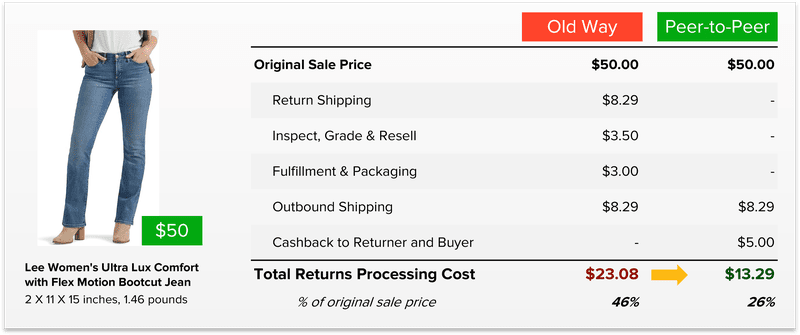
Amazon FBA Fees to Increase in 2022
In this article
 6 minutes
6 minutes
On January 18, 2022, Amazon will increase FBA fees for fulfillment, removal, and disposal. It will then follow up on those changes with increases to storage fees on February 1st, along with a brand-new long-term storage fee that will kick in on inventory sooner than the current 365 days.
Many Amazon FBA sellers struggle with the slim margins imposed by fierce competition, so even seemingly small changes have an outsized impact on a business plan. Read on to make sure that you know exactly how much more you’ll have to pay Amazon in 2022 in FBA fees, and decide whether it’s time to come up with an Amazon FBM backup plan.
How are Amazon FBA Fees Changing in 2022?
Unsurprisingly, Amazon FBA fees in 2022 will increase across the board. All of the biggest categories will see increases – fulfillment fees, storage fees, and removal and disposal. So – what are those changes?
Amazon FBA Fulfillment Fee Changes
Amazon will hit every size tier with a fulfillment fee increase, and percentage increases will range from 2% on the low end to as much as 12% on the high end.
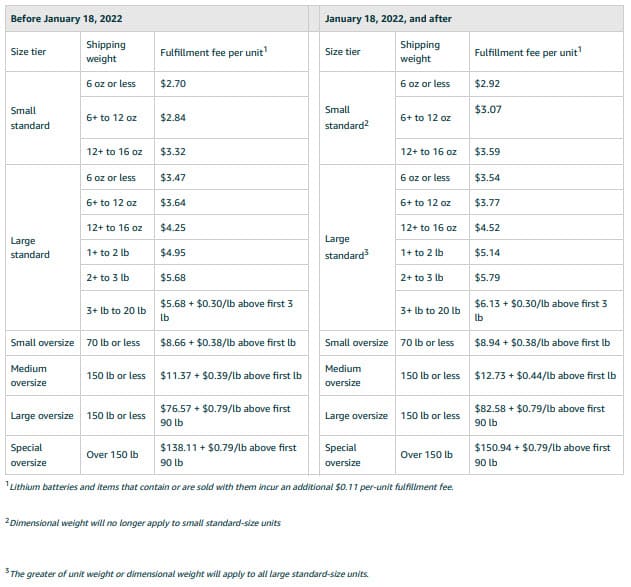
Source: Amazon Seller Central
Notably for many sellers, each of the Small Standard categories will see an increase of 8%. For the smallest items, that will result in a $0.22 increase, and for the larger items in that range, the fee will go up by $0.27. It sounds like a small increase, but sellers know how much even ten cents matters for small, low-margin products. This change will cut already-thin margins and likely force some sellers into the unenviable choice of either dropping part of the product line or raising prices and risking a severe drop in sales.
An Amazon FBA seller on r/FulfillmentByAmazon sums up the dilemma well: “If I was assessed the [2022] FBA fees retroactively for the past 4 months it would average out to a cut of 22.5% at the unit level net profit. All you can do is raise prices, but when Amazon is your competitor, that’s not always possible. Great.”
Amazon FBA Storage Fee Changes
Of course, Amazon isn’t stopping at raising fulfillment fees. They will make two separate changes to FBA Storage Fees – 1) they’ll raise rates and 2) they’ll institute a new, more punishing long-term storage fee.
FBA Storage Fees will increase by $0.08 per cubic foot, or 10.6% on February 1st, 2022. Like the fulfillment fee rate increase, this is a seemingly small change, but given that Amazon FBA sellers are already operating in a cutthroat, low-margin environment, the overall effect of a few small changes to fees can be punishing.
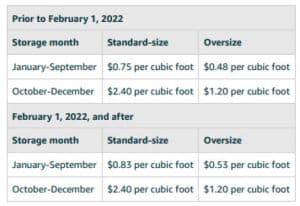
On top of that, Amazon is also tightening their definition of long-term storage. On May 15th, 2022, they will introduce a brand-new “aged inventory surcharge” to units that have been in Amazon’s fulfillment centers for 271 to 365 days. While that time period used to accrue zero additional storage fees, it will now add $1.50 per cubic foot on top of regular storage fees, nearly tripling storage cost.
There’s simply more demand for FBA than Amazon can fulfill, so they’re able to make changes like this to squeeze more out of sellers and cut all but the best sellers out of their network. This is the logical extension of changes like their April 2021 adjustment to FBA inventory limits, which are designed to optimize what inventory sellers place with FBA and punish those who don’t adhere to their ever-stricter standards.
Amazon FBA Removal and Disposal Fee Changes
Finally, Amazon is more than doubling the Removal or Disposal Order Fee for most SKUs. Missing on a new product, or getting undercut and outcompeted is about to become a lot more expensive. If you keep trying to sell a struggling product, you’ll face the early kick-in to long-term storage fees as detailed above. If you decide to cut the product, you’ll pay much more per unit.
In fact, every product size except for the smallest will see its Removal or Disposal Order Fee more than double. A SKU between 1-2 lbs, for instance, will increase for $0.35 to $0.75 per unit – a 114% jump.
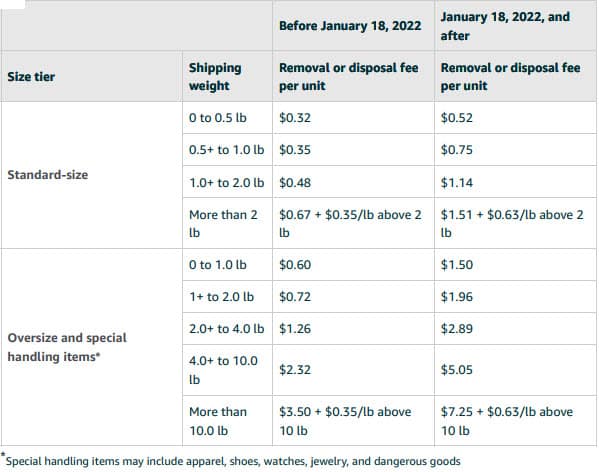
As mentioned above, this change is aimed squarely at removing all but the fastest-moving SKUs from Amazon FBA. If you’re uncertain about how a new product will perform, or you see existing products getting undercut and pushed out of the Buy Box by cheap competition (or competition from Amazon itself), then you need an efficient Amazon FBM solution to keep selling.
Cahoot’s Alternative to Amazon FBA
Cahoot’s excellent FBA alternative can fully replace FBA or serve as an affordable backup. And it’s much more than that – it’s the most flexible solution in the marketplace and easily integrates and ships orders for every eCommerce sales channel. With our innovative peer-to-peer fulfillment network, multi-channel fulfillment with nationwide 1-day and 2-day delivery is the norm.
Unlike other networks that are collections of 3PLs, Cahoot’s innovative approach empowers merchants across the country to fulfill orders for one another. Our peer-to-peer network is a collective of highly vetted eCommerce retailers who offer up excess warehouse space and resources to provide high-quality order fulfillment to other merchants.
As a result, costs are typically lower than what you get with a traditional 3PL fulfillment company, and service levels are higher. Merchants can use the network solely for outsourced fulfillment – similar to FBA, or they can choose to fulfill orders for other merchants and offset some of their own outsourced fulfillment costs.
Offer 1-day and 2-day shipping at ground rates or less.
Related Blog Posts

The Ultimate Guide to Selling and Winning on Amazon Seller Fulfilled Prime
Most people are familiar with the requirements that Amazon expects sellers to meet, but far fewer are aware of the roadblocks that make success hard to achieve. An even smaller number are aware of the strategies they can deploy to meet Amazon’s criteria and surpass them.

Amazon Buy With Prime: A Game-Changer for Customers, But a Trojan Horse for Merchants
For customers, Buy With Prime is a great service, but for ecommerce merchants, it’s a Trojan Horse. Amazon Prime circumvents the entire order checkout process from the merchant’s platform, and payment processing goes through Amazon
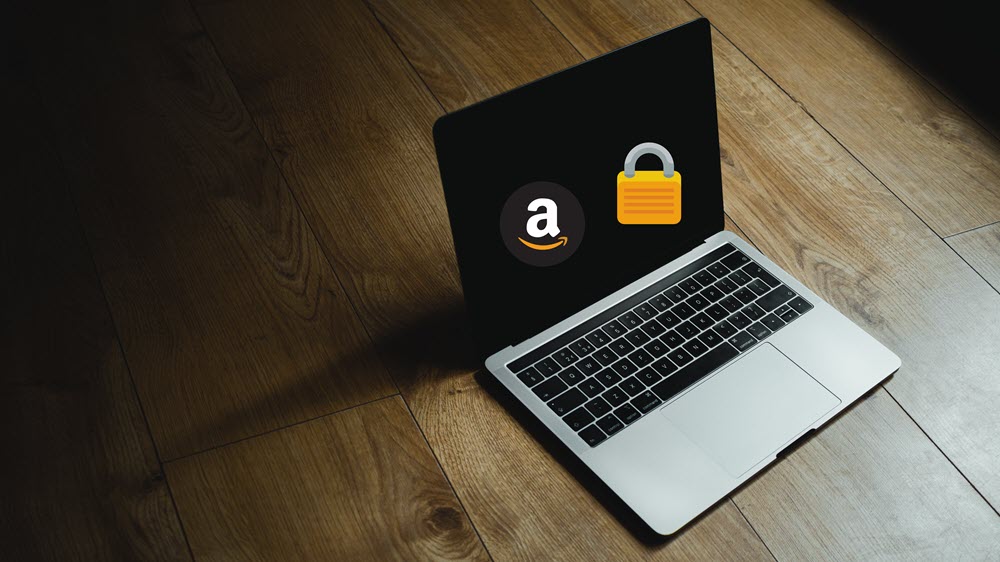
Protect Your Amazon Listings from Search Suppression, Hijackers, and Stockouts
Amazon is a competitive platform. You need to have a quality product, excellent listing content, and plenty of reviews to catch the attention of busy consumers

Up to 64% Lower Returns Processing Cost

How to Choose the Right 3PL Company
The thrill of growing your own ecommerce business can quickly give way to backaches as you personally store and fulfill tens or hundreds of orders per day. And that’s not even mentioning the garage-full of inventory that you can hardly navigate!
On the other end of the spectrum, large businesses can also easily see their logistics overwhelmed by growth. They may need additional warehouse space, or find it challenging to expand their own warehouse, new fulfillment capabilities, or a better footprint across the country to reduce final mile shipping distances.
Both of these types of sellers need the same thing: a third-party logistics (3PL) partner.
In this article, we’ll provide a quick rundown of what a 3PL does before providing an in-depth guide to what you should look for in a 3PL when you need to outsource fulfillment.
What is a Third-party Logistics (3PL) Company?
A third party logistics (3PL) provider, broadly speaking, is a company that handles inventory management, warehousing, and fulfillment for retailers. The industry has undergone a massive transformation over the past two decades as retail growth has shifted online, but the basic principles have remained the same. Logistics management is fundamental to 3PL services, which focus on executing logistical tasks efficiently.
3PLs receive inventory from their customers, and then they safely store it in the manner required to support efficient outbounds. They integrate with their customers’ sales channels, so that when an order comes in, the 3PL fulfills it without intervention from the seller. Within that broad characterization, there’s as much variety in the 3PL industry as there is in retail.
Some 3PLs focus exclusively on retail replenishment, while others take the opposite approach and only work with ecommerce sellers. Some will specialize based on the type of goods fulfilled, as many require special handling or conditions in the warehouse (such as oversized items or refrigeration). Others will focus on creating dense networks in certain regions of the country, while many now compete with Amazon to create robust nationwide networks.
Definition of 3PL
A 3PL, or Third-Party Logistics provider, is a company that offers outsourced logistics services to manage one or more aspects of a business’s supply chain operations. This can include inventory management, warehousing, transportation, and distribution. By partnering with a 3PL provider, businesses can streamline their logistics operations, reduce costs, and improve efficiency. Third party logistics providers bring specialized expertise and technology to the table, allowing businesses to focus on their core competencies while leaving the complexities of logistics operations to the experts. Whether it’s managing inventory, optimizing warehouse space, or coordinating transportation services, a 3PL provider can significantly enhance the overall performance of a supply chain.
Benefits Of Using A 3PL Provider
Using a 3PL provider can bring numerous benefits to a business, including:
- Cost Savings: Third party logistics providers can help businesses reduce their logistics costs by leveraging their expertise, technology, and economies of scale. By outsourcing logistics operations, businesses can avoid the investments required for infrastructure and personnel.
- Improved Efficiency: 3PL providers can help businesses streamline their logistics operations, reducing the time and effort required to manage inventory, transportation, and distribution. With advanced warehouse management software and transportation management systems, 3PLs can optimize every step of the logistics process.
- Increased Scalability: As businesses grow, their logistics needs become more complex. A 3PL provider can help businesses scale their logistics operations quickly and efficiently, without the need for significant investments in infrastructure or personnel. This flexibility allows businesses to adapt to changing market demands with ease.
- Enhanced Customer Service: 3PL providers can help businesses improve their customer service by providing fast, reliable, and flexible logistics solutions. With efficient logistics operations, businesses can ensure timely deliveries and accurate order fulfillment, leading to higher customer satisfaction.
- Access to Specialized Expertise: 3PL providers offer access to specialized expertise and technology, such as warehouse management software and transportation management systems. This allows businesses to benefit from the latest advancements in logistics without having to develop these capabilities in-house.
How Do 3PLs Work?
Generally speaking, a 3PL owns two critical aspects of the ecommerce logistics chain: inventory storage and pick & pack fulfillment. As reverse logistics become more prominent, many 3PLs are also building out the ability to operate “in reverse” to help their clients manage returns.
In this section, we’ll provide a run-down of standard 3PL processes that make the operation hum.
Technical Integration
To start, ecommerce 3PLs need to be able to see orders received by their clients in real time in order to be able to fulfill them quickly. Before the rise of ecommerce, and even in the early days of the ecommerce revolution, speed was not a priority for order fulfillment. Many clients would manually send their 3PLs orders in Excel spreadsheets (or even in Word docs) at the end of each day or week, and then the 3PL would get to work fulfilling the orders.
You don’t need us to tell you that the world works a bit differently these days.
Today, any 3PL set up for ecommerce insists on building a direct integration between their systems and a customers’ sales channels. Without an instantaneous feed of orders from ecommerce channels like Amazon or Shopify, orders wouldn’t be shipped on time, and sellers would be faced with a deluge of unhappy customers asking why their shipments are delayed. The best 3PLs have pre-built integrations with major marketplaces, shopping carts, and ecommerce platforms, so integrations are as simple as a few clicks for their customers. They also have open APIs that support more custom integrations to reflect the diversity of tech stacks that modern sellers have built.
Inventory Receiving
Next in the process is receiving – after all, a 3PL can’t fulfill orders with inventory that it doesn’t have. Sellers can send their inventory via freight directly from their manufacturer to their 3PL, while giving the manufacturer any receiving specifications the 3PL might have. This minimizes the number of intermediary stops for inventory, which reduces cost and the potential for inventory to get stuck inaccessible in the wrong location.
Generally speaking, 3PLs prefer to receive pallets with as few SKUs as possible, prepped for shipping, and pre-labeled. This “platonic ideal” of receiving, though, is rarely fully true, and so many 3PLs offer inventory prep services to get items ready for shipping. This enables the seller to still ship directly from the manufacturer to the 3PL, even if the manufacturer isn’t well versed in how to prepare items for ecommerce.
Long receiving times are a big problem in the eCommerce world – Amazon FBA, for instance, takes up to 14 days to get inventory that is at their fulfillment centers ready to ship. A two week wait is unacceptable for sellers who could see their best sellers go out of stock while waiting. That’s why Cahoot’s fulfillment services offer an industry-leading receiving SLA.
Inventory Storage
Much of the floorspace in a warehouse is dedicated to inventory storage, but the way in which 3PLs store inventory has changed dramatically thanks to the shift towards ecommerce order fulfillment. A cloud-based warehouse management system (WMS) can enhance visibility and streamline inventory management across multiple fulfillment centers.
Warehousing services that focus on B2B replenishment store their inventory efficiently in large bundles – think of a full pallet of goods, or a pallet of goods off of which multiple cases can quickly be picked.
Inventory storage at a warehouse that fulfills ecommerce orders is instead optimized so that orders can easily be picked in “eaches” (or single quantities). The speed with which a warehouse picker can get to items and pull one or more out is vital to operations because they have to repeat the process hundreds of times per day.
Warehouse Fulfillment
Pick and pack fulfillment is the term for the process by which 3PL personnel select the items that a customer ordered and put them in boxes ready to ship. This is the most vital part of the process for ecommerce sellers, because speed and accuracy underpin a positive customer post-purchase experience.
Amazon Prime’s continual push to cut delivery times shorter means that warehouses can’t wait to fulfill orders; each customer that presses “buy” needs to have their item picked, packed, and dropped off with the carrier that same day. Anything less will result in a delivery delay, and delivery delays lead to negative customer reviews.
Next-gen 3PLs like Cahoot have developed intelligent software controls to maximize the speed and accuracy of picking and packing in their warehouses. Cahoot software, for instance, intelligently directs warehouse personnel to maximum speed and efficiency with pick lists of products. The pickers then use barcode scanners to ensure that the right product is picked every single time. In this way, Cahoot achieves both speed and accuracy, ensuring the zero-defect, fast fulfillment that customers demand.
Returns Processing And Reverse Logistics
eCommerce warehouses must be able to handle returns – those that don’t leave their customers unable to provide a critical service to the end customer. Marketplaces again have led the market with super-easy no-fault returns policies, so online merchants of all stripes are under heavy pressure to offer the same on their DTC sites. So, warehouses have to be able to receive returns, assess whether they’re damaged or not, and process them back into available stock whenever possible to minimize loss.
Signs that Your Organization Needs a 3PL Provider
If your business is experiencing any of the following signs, it may be time to consider partnering with a 3PL provider:
- Rapid Growth: If your business is growing rapidly, a 3PL provider can help you scale your logistics operations quickly and efficiently. They can provide the necessary infrastructure and expertise to handle increased order volumes and complex logistics requirements.
- Complex Logistics Needs: If your business has complex logistics needs, such as multiple warehouses, transportation modes, or inventory management requirements, a 3PL provider can help you manage these needs effectively. Their experience and technology can streamline logistics operations, ensuring smooth and efficient processes.
- High Logistics Costs: If your business is experiencing high logistics costs, a 3PL provider can help you reduce these costs by leveraging their expertise, technology, and economies of scale. They can identify inefficiencies and implement cost-saving measures to optimize your logistics operations.
- Limited Logistics Expertise: If your business lacks logistics expertise, a 3PL provider can provide you with access to specialized knowledge and technology. Their experience in managing complex logistics operations can help you overcome challenges and improve overall efficiency.
What Should You Look for in 3PL Companies?
If you’re an ambitious seller looking to boost your growth, you should know that the right 3PL can be a revenue driver, and not just a cost center. The best 3PLs will improve your delivery experience, which makes for happy customers that buy again and again. They can also help you control and reduce shipping costs by leveraging partnerships with various carriers.
Here are the most important things to look for in your 3PL:
Nationwide Warehouses
Even if you’re small now, you can still strategically distribute your inventory to unlock affordable fast shipping. That is, if your 3PL has nationwide USA fulfillment centers. A third party logistics company can enable businesses to expand their operational reach into new sales channels and regions.
A McKinsey study found that a whopping 90% of US online shoppers expect free two- to three-day shipping, and Amazon metrics show that turning on the Prime badge can net 50% growth for a product. If you or your current 3PL only have one or two locations to ship from, though, two-day shipping to customers halfway across the country requires eye-watering expedited shipping rates. That’s where strategic inventory distribution comes into play.
The best 3PLs offer true national fulfillment services by placing inventory in 4+ locations strategically across the country. The benefit to you is that these networks will cover 99%+ of US consumers with 2-day shipping at economy shipping rates. No matter where your customer wants their product shipped, you’ll have inventory nearby. They get their item lightning-fast, and you pay the cheapest possible rate.
User-Friendly Warehouse Management Software
If you can’t get real-time updates on the status of your orders, your inventory levels, and shipping and fulfillment costs, then you’re not working with a cutting-edge 3PL.
Older (and even some of the new) 3PLs can feel like a black box into which sellers send their inventory, and then they have no idea how much of what product they have left due to inconsistent communication.
The best 3PLs, on the other hand, have software that proactively notifies customers with critical information. Unfortunately, things go wrong all the time in the logistics world. It can be as simple as an undeliverable address input by a customer, and as complex as a worldwide shipping crunch. Your 3PL shouldn’t leave it up to you to find issues in fulfillment – for instance, the software should alert you when a customer places an order with an undeliverable address. You can then fix the issue with the address before it turns into a late shipment, and you’ll keep the customer happy.
Top-Tier Reliability
Reviews are your lifeblood, and a happy customer is a repeat customer. You probably can recall poor reviews and lost customers that were due to errors from your 3PL that you couldn’t control!
The best 3PLs almost never make mistakes thanks to the technology they use to ensure accurate and fast picking. Look for an on-time fulfillment rate of 99.9% or higher – anything less signals a 3PL that isn’t built for the rigorous demands of modern eCommerce.
“I was struggling to find even a handful of orders that we’ve had issues with… I can’t even remember a single order that was shipped out late.”
~ Michael Pursey, COO of Cali’s Books
Speak to a fulfillment expert
Cahoot achieves zero-defect fulfillment with a mix of top-tier professionals and top-tier software. Our commitment to high standards starts with the warehouses that we accept into our network: we turn away many more than we accept, and we demand that they have a long track record of demanding ecommerce fulfillment environments like executing Seller Fulfilled Prime. Then, they install our rigorous software on top of their already excellent operations, and the result is a 3PL that leads the way with over 99.9% on-time fulfillment and 99.95% order accuracy.
Flexibility and Scalability
It shouldn’t be hard to connect your Amazon account and Shopify store to your 3PL – the best ones have pre-built integrations that will do it with a few clicks.
Ecommerce merchants are pushing into multiple sales channels to maximize growth, and your 3PL should be able to easily integrate with all of them. Their integrations make it easy to switch fulfillment and get up-and-running with the new service in no time.
Scalability goes past just easy integrations, though. Many 3PLs, and especially many of the newer “tech enabled 3PL networks”, are optimizing narrowly for only certain types of products. Certain 3PLs, for instance, specialize in the highly specific needs of merchants who sell and ship food products or electronics, both of which require more care and attention to detail than other goods.
The flexible Cahoot peer-to-peer fulfillment network, in contrast, can handle efficient retail replenishment as easily as it handles low-cost fast ecommerce fulfillment. We handle challenging beauty products’ fulfillment as readily as we excel in consumer packaged goods. Unlike others that have built or partnered one type of warehouse over and over across the country, we install our flexible software in warehouses with diverse specialties. The only common thread they have is their excellence. The result is that we scale our customers’ operations no matter their selling channel; for instance, some of our most successful customers are winning growth on Amazon, Shopify, and with retail stores like Nordstrom all at the same time.
Responsive Customer Service
Finally, you should be able to get in touch with your 3PL easily to troubleshoot challenges and come up with fixes. Look for a 3PL that offers you a real person to work with your account, and multiple ways to get in touch with them. If it’s a small issue, live chat will do. Thornier challenges, on the other hand, should be governed by a detailed ticket system. And of course, you need a phone line for critical issues.
Cahoot clients agree that our service team is the lifeblood of our 3PL. Our detailed but user-friendly onboarding process ensures that our merchants are able to smoothly transition from their previous fulfillment solutions, while also enabling us to get to know your business in detail to better fit your needs. With other big 3PLs, you’ll have to re-explain your business and its requirements every time you submit a ticket. With Cahoot, our US-based team takes the time to learn who you are and what you need to succeed, so that if an issue arises, they can get right down to fixing it immediately.
3PL vs. 4PL: What’s the Difference?
A 3PL provider manages a specific aspect of a business’s supply chain operations, such as inventory management or transportation. They focus on optimizing individual components of the supply chain to improve efficiency and reduce costs. On the other hand, a 4PL provider manages the entire supply chain, including multiple 3PL providers. Acting as a single point of contact for all logistics needs, a 4PL provider offers a more comprehensive and integrated logistics solution. They oversee the entire supply chain, from procurement to distribution, ensuring seamless coordination and optimization of all logistics operations. By managing the entire supply chain, a 4PL provider can provide businesses with a holistic approach to supply chain management, enhancing overall performance and efficiency.
Top 3PL Companies
Now that you know what to look for, how do a few of the top players in the industry stack up? We’ve provided a primer to help jump-start your research.
Fulfillment by Amazon (FBA)
FBA, the elephant in the room, is Amazon’s fulfillment solution for 3rd party merchants selling on their marketplace.
Amazon Buy with Prime
You can also use Amazon’s fulfillment network, FBA, to fulfill direct-to-consumer (DTC) orders from your own website. Buy with Prime is an extension of their existing service, Amazon Multi-Channel Fulfillment (MCF).
Walmart Fulfillment Services
Walmart has built a fulfillment network to compete with FBA, named Walmart Fulfillment Services. Like FBA, it’s built solely for 3rd party sellers selling on Walmart.com.
ShipBob
ShipBob is a 3PL that focuses on serving eCommerce merchants. They have a nationwide network of fulfillment centers that enable fast shipping, but they charge extra for guaranteed 2-day shipping.
Red Stag Fulfillment
Red Stag Fulfillment is a more traditional 3PL, with only a few locations in the United States. They offer B2B fulfillment in addition to B2C, as they have a wider focus than eCommerce.
Cahoot: The Next Gen 3PL
Cahoot’s fulfillment network is built for eCommerce. We’ll help you delight your customers with a stellar, Amazon-like delivery experience while reducing the amount of time your team spends on operations. We support your growth, no matter where you sell – we have pre-built integrations with major marketplaces and shopping carts and we power efficient B2B fulfillment. Our tailored solutions help streamline supply chains, reduce costs, and improve customer satisfaction.
Our innovative peer-to-peer model offers low-cost, fast fulfillment by design. We’re “peer to peer” because our fulfillment network is made up of ecommerce sellers with excess capacity in their own, excellent operations. We help them fully utilize their capacity by fulfilling for other sellers like you, and as a result, our pricing is typically lower than that of other top providers listed above. Because we only add the best of the best warehouses to our network, we also beat the competition on fulfillment speed and reliability.
If you’d like to find out how Cahoot can help your business, please get in touch with us. We can’t wait to show you how easy operations can be.

Up to 64% Lower Returns Processing Cost

Cahoot Partners with Walmart Marketplace to Enable Online Retailers to Offer Nationwide 1-Day and 2-Day Delivery
Marketplace Sellers Leverage Peer-to-Peer Fulfillment to Grow Sales with Affordable Nationwide Fast Shipping.
BRIDGEPORT, CT (August 30, 2021) – Cahoot, the world’s first peer-to-peer eCommerce fulfillment network, announced its partnership and integration with Walmart (NYSE: WMT). Cahoot is now a certified shipping and fulfillment solution for Walmart’s marketplace sellers.
Cahoot’s revolutionary peer-to-peer fulfillment model enables brands and online retailers to affordably provide one-day and two-day delivery nationwide. With its rapidly growing network of eCommerce order fulfillment centers coast-to-coast, Cahoot is quickly becoming the fulfillment provider of choice for high-volume sellers on marketplaces such as Walmart, Amazon, and eBay and eCommerce platforms such as Shopify, BigCommerce, and Magento.
“We’re excited to integrate with Walmart ahead of the record-breaking holiday season just around the corner,” said Cahoot Founder and CEO Manish Chowdhary. “The industry’s rapid growth has fulfillment capacity bursting at the seams. Our novel peer-to-peer model solves this problem by unlocking thousands of eCommerce merchants’ excess warehouse space and fulfillment capacity. Collectively, the Cahoot network is doing for eCommerce fulfillment what Airbnb did for lodging.”
A Reliable Solution for Walmart’s Free 2-Day Delivery Program
Cahoot’s Walmart Marketplace Integration enables approved sellers to participate in Walmart’s 2-Day delivery program and display the Free 2-day shipping badge on their marketplace listings. Walmart has observed that sellers with this badge enjoy an up to 50% increase in conversion, making it one of the most powerful ways sellers can grow their sales. To help merchants delight their customers with exceptional delivery experience, Cahoot provides affordable same-day fulfillment 6 to 7 days a week and maintains a strict service level agreement of 99.95% on-time fulfillment and 99.9% order accuracy.
Flexible Across Channels & Works Seamlessly with In-House Operations
The patented Cahoot eCommerce order fulfillment platform provides eCommerce merchants with unsurpassed ease of use and complete visibility into inventory, orders, fulfillment performance, and package tracking – across all sales channels. Unlike traditional 3PL networks, the Cahoot network can seamlessly integrate with existing merchant fulfillment, which upgrades their strategy without introducing more complexity. With Cahoot, orders automatically flow to the optimal shipping point, whether it’s a Cahoot fulfillment center or the merchant’s own warehouse.
Cahoot has really helped us grow our multi-channel sales. We use Cahoot to fulfill our Walmart 2-Day orders and our Amazon standard and SFP orders. In addition to saving us money, we really like that their software and their fulfillment network work seamlessly with our own in-house fulfillment operations. Our old 3PL couldn’t do that.

Kris Koesema
Battery Jack
The Power of Many
Like the Airbnb marketplace of homeowners and travelers, the patented Cahoot order fulfillment network brings together the collective power of SMBs and their warehouses to fulfill orders, thus reducing fulfillment costs and expediting delivery.
Cahoot is available for merchants looking to expand their reach for one- and two-day delivery services across all selling channels, including Amazon, Walmart, eBay, Shopify, BigCommerce, and more. Merchants can reach a Cahoot fulfillment expert at www.Cahoot.ai.
ABOUT CAHOOT
Cahoot is the world’s first peer-to-peer eCommerce fulfillment network. It helps online businesses offer nationwide 1-day and 2-day deliveries. In addition, Cahoot’s model is the lowest cost by design because it enables merchants to store and ship merchandise for each other. This novel business model also allows merchants to make extra money using their existing warehouse space and personnel.
Offer 1-day and 2-day shipping at ground rates or less.
Recent Blog Posts
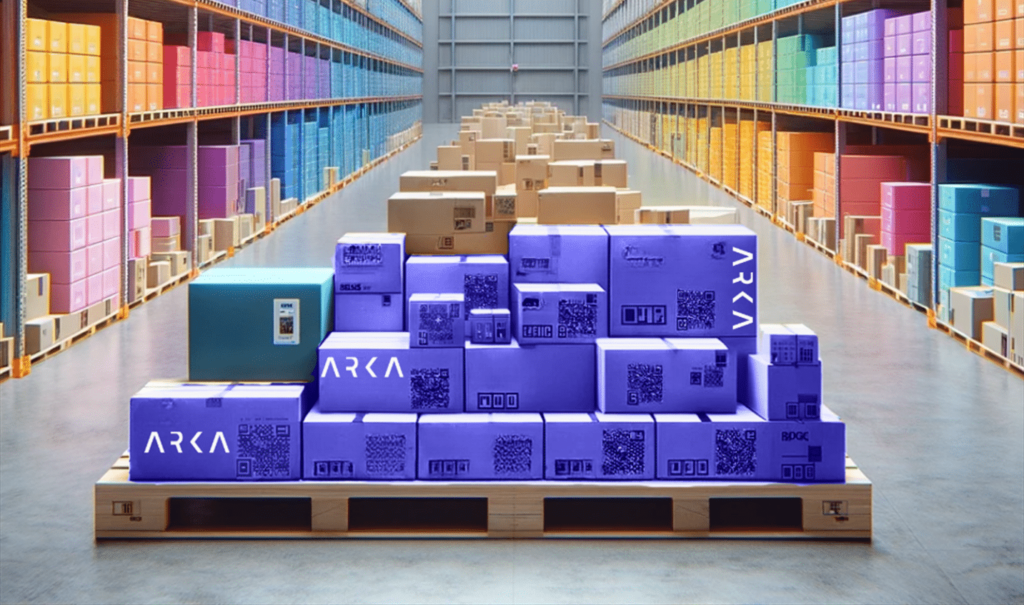
Packaging Design That Will Make Fulfillment Easy and Cut Costs
E-commerce Revolution with Strategic Packaging Solutions Like anyone in the e-commerce world, small business owners are always looking for ways to streamline their operations and
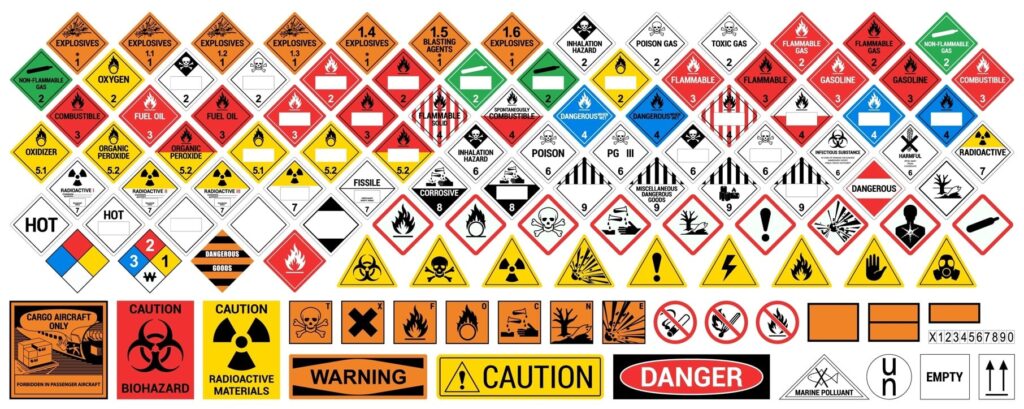
USPS Hazmat Shipping Guidelines – How to Ship Fast While Staying Compliant
Hazardous Materials What is a Hazardous Material? What Items Are HAZMAT? Classes of HAZMAT Items What Classes Can Ship on Various USPS Services? What Changes

Protect Your Amazon Listings from Search Suppression, Hijackers, and Stockouts
Amazon is a competitive platform. You need to have a quality product, excellent listing content, and plenty of reviews to catch the attention of busy

Up to 64% Lower Returns Processing Cost

The Importance of Logistics in Ecommerce Fulfillment
In this article
 32 minutes
32 minutes
Listen to podcast here.
Podcast: Fast Ecommerce Shipping How to Offer It to Grow Your Brand – What’s Working in Ecommerce (Ep. 45)
The host of a podcast on e-commerce marketing and owner of Caravan Digital, Eagan Heath, interviewed Manish Chowdhary, an expert in logistics and ecommerce order fulfillment and the CEO of Cahoot, a full-service order fulfillment services network. They discussed the importance of warehouse logistics in the e-commerce sector, which can affect profitability and the fulfillment strategy of ecommerce brands and retailers. Chowdhary explained the complexity of order logistics with inventory supply chain issues, international shipping, inventory storage, and warehousing strategy. Cahoot offers flexible and affordable order fulfillment services for B2B, wholesale, direct-to-consumer, and Amazon’s Seller Fulfilled Prime (SFP) program. They also have the capacity to offer one-day and two-day nationwide free delivery, which is essential for e-commerce brands to remain competitive. Ecommerce brands that fail to offer fast and free shipping are at a strategic disadvantage, as consumers are accustomed to these order fulfillment services, which are associated with customer satisfaction and increased revenue.
Eagan Heath:
Welcome everyone to another episode of What’s Working in E-Commerce. I’m your host, Eagan Heath, the owner of Caravan Digital. We’re a direct to consumer e-commerce marketing agency. We help with paid search, paid social, and email automation. Today I’m very fortunate because I’m speaking with an expert in logistics and fulfillment. His name is Manish Chowdhary he is from Cahoot. Manish, welcome.
Manish Chowdhary:
Well, thank you for having, Eagan. Really excited to be here.
Eagan Heath:
Yeah. Tell us a little bit about why e-commerce merchants might want to use a third party logistics (3PL) company or a solution like that.
Manish Chowdhary:
So Eagan, if you look at what’s happening with e-commerce and logistics, I’d like to start out by saying that shipping and order fulfillment is such a crucial part of being successful online, that it is something that every merchant already knows. All your audience probably is already aware. So I’ve even coined a phrase called half your shopping experience is your shipping experience. So it is that important. And when it comes to e-commerce shipping, it can make or break once profitability. It is that crucial because if the merchants are not looking at that in a critical fashion, then they’re actually not taking a complete view of their business.
Manish Chowdhary:
And e-commerce and logistics has become a very, very complex topic with inventory supply chain issues. Getting goods from overseas, if you have manufacturers outside, the cost of moving those containers by ocean freight, getting them to the ports in the US which are choked. And then storing and housing the inventory. And then finally, your warehousing strategy because you can’t bring an inventory fast enough, and so on. So I can keep going, but I’m going to turn it back to you so you can break it down for the audience.
Eagan Heath:
Yeah, that’s great. Hearing you talk about that, it strikes me that it’s every bit as complicated as the digital marketing and probably much more. So my hat’s off to you.
Manish Chowdhary:
Well, thank you, Eagan. In fact, when merchants are not taking… I’ll give you a very simple example just to set the stage is, all the carriers implement what we call peak season surcharge, and peak season delivery surcharge. This is in addition to the fuel surcharge. And this can range anywhere from 50 cents all the way to two, $3 per package. So if you’re coming from a marketing perspective and in Q4, you’re not accounting for that $2 extra order fulfillment or the shipping surcharge, all your auto AS, all your return on advertising spend, how much money you should allocate, all of that math goes out the door. So logistics is like an iceberg. You only see one 10th of it outside and the remaining is quite deep.
Eagan Heath:
Yeah, that’s amazing. And like you said, this is really affecting your margins, which can affect whether your advertising or your marketing is profitable. And so, that’s why we’re speaking about this today. Tell us a little bit about Cahoot, of what you guys do, and just how you got into this.
Manish Chowdhary:
In the interest of time, I’ll keep it short in terms of Cahoot is a full service order fulfillment services network. So we essentially help ecommerce brands and retailers execute the most merchant centric fulfillment strategy. Which means both B2B, wholesale, direct to consumer, fulfillment for all channels from Amazon, Shopify, and also supporting their programs such as Seller Fulfilled Prime (SFP), which is a two-day nationwide free delivery, including one day delivery for 20% of the time. So Cahoot is a cutting edge, modern, what we call peer-to-peer order fulfillment services network. And I can explain that a little bit later. But essentially, we help… Think of Cahoot a bit like FBA, but a lot more flexible and a lot more affordable.
Eagan Heath:
Interesting. So I’m looking at your website here. It’s cahoot.ai, correct?
Manish Chowdhary:
That’s right.
Eagan Heath:
Yeah. I see. Why is Cahoot better than other 3PLs? You talked about lowest cost by design, scales to help you grow. And I was going to ask about this, the rigor to power the most demanding fulfillment. I said SFP is too tough for other 3PLs. And you just said what that is, that’s basically one or two-day shipping. Is that right?
Manish Chowdhary:
Yeah, SFP stands for Seller Fulfilled Prime. So is essentially Amazon’s program for certain sellers who have been pre-approved to get the prime badge and still fulfill the orders outside of FBA. So there’s a full webinar on our website if anybody’s interested in checking it out. It’s a very, very hard program to qualify and very hard to stay on top of. And Cahoot does that in addition to supporting whatever order fulfillment strategy makes the most sense for our merchants.
Eagan Heath:
That’s great. And for e-commerce brands that are listening, if they’re not doing one or two-day shipping like this now, make the case a little bit. Obviously, we’ve really gotten used to this with Amazon. How important is it to be able to fulfill it that quickly? And also what does a brand need to have in place to be able to do that?
Manish Chowdhary:
Well, I mean it’s really, really important. In fact, if you’re not offering one day, two-day free shipping on your website, you know are at a strategic disadvantage because consumers are looking for that. If you look at Amazon Prime, there are about over 200 million Amazon Prime members and they have gotten used to two-day delivery, used to be the norm, Eagan, a few years ago. I mean now Amazon is rapidly moving to one day delivery and many markets, the 10 markets where Amazon is doing same day delivery. So any brand that says that my customers are not demanding one day, two-day delivery, I will challenge you on that. And customers are not going to come and tell you, they’ll just go elsewhere.
Eagan Heath:
And in terms of is there a certain amount of inventory that sellers need to have or anything like that, how do they think about maybe the inventory and logistics side of it so that they can do this?
Manish Chowdhary:
In fact, I’ve got some visuals if you like. I can pull them up and we can go over how does Amazon-like Fulfillment work. So let’s see. All right, let’s go right into it. I mean, I want to share with the audience what you’re looking at on the screen is, there are the three top tech behemoths. You’ve got Amazon, which has about 34-35% of all e-commerce GMV in the US. Walmart is trailing behind. And then Shopify is another very popular e-commerce platform. And we are going to use Shopify as the DTC poster child or DTC representative. So Amazon, if you want to sell on Amazon, Amazon has its own fulfillment service, very popular Amazon FBA. Walmart has Walmart Fulfillment Services, which is rather new. And then Shopify originally tried to implement or launch Shopify fulfillment services network in 2019. That didn’t quite work out, wasn’t doing so well. So in April of this year, they acquired a company called Deliver, which actually competes with my company, Cahoot.
Manish Chowdhary:
But the challenge with this, Amazon of course, wants to use FBA. Walmart forces you to use WFS now. And Shopify introduced a new program called Shopify Promise, which is expected to compete with Amazon’s Amazon Prime. And the biggest challenge with these programs is they’re very self-serving. For example, Amazon has limited warehouse space, so they will limit how much inventory you can send to them. And they do that limitation by certain methods. The Q4 storage fees are three times the storage fees that Amazon would charge in the first three quarters. So by using such prohibitive high pricing, they’re trying to control the usage. And of course, FBA is great when you sell your products on Amazon and use FBA to fulfill it.
Manish Chowdhary:
However, the merchants want to sell on all different channels because shoppers are everywhere. You cannot contain yourself to selling on one channel. But if I take an order from Walmart, I’m actually prohibited by law or by rules of Walmart that I shouldn’t use FBA, because Walmart wants us to use Walmart Fulfillment Services. If I take an order on Shopify or eBay, then I’m going to pay considerably higher to Amazon for order fulfillment because Amazon, of course, wants everyone to sell on Amazon and that’s why they want to incentivize this. So what we see is siloed strategy.
Manish Chowdhary:
So when you think from a merchant’s perspective, it’s hard enough to run a business. And now if you have to send inventory to three different networks, and God prohibit, if you are selling on eBay and many other marketplaces, it becomes even more challenging. So our view is that these strategies, while they are very attractive in some cases, it tends to tie the merchant down, and it’s not the most affordable strategy from a bigger holistic standpoint. And you asked this question, Eagan, how does Amazon-like fulfillment work? How do you offer one day, two-day delivery nationwide? So I want to break this down for your audience. I can take a pause if you have a question, or I can keep going.
Eagan Heath:
No, this is great. Part of what I’m understanding is if you’re doing fulfillment by Amazon, and you’re selling on Walmart, and then you’re doing some other one, you’ve got basically your products in different fulfillment centers, and you’ve got to kind of manage that, versus this is an alternative to handle all three or more through one service. Is that right?
Manish Chowdhary:
That is exactly right. And we know, and perhaps you can attest to that, that merchants should be selling on as many channels as they possibly can because shoppers are not limited to one particular marketplace, even as popular as Amazon, it’s certainly not a hundred percent of the market. And therefore, there could be less competition on other places. So we encourage merchants to make the products visible at as many places as they can and also of course, focus on their direct to consumer website.
Eagan Heath:
Yeah, that’s excellent. All right. So what I see here on the screen of the different locations of if we have two, four, or nine locations, tell us a little bit about this.
Manish Chowdhary:
Yeah, so this is a map for those of you who are watching the screen. It’s essentially breaks it down that how do you make free and fast shipping possible? How do you make Amazon-like shipping affordable? Of course, we cannot afford to ship using the expensive overnight air or two-day air service. So the most economical is the ground service like a UPS ground or USPS first class and so on. And what this illustrates is that if you want to target two-day delivery nationwide, you need to have at least four strategically located warehouse, or four strategic fulfillment locations. And if you look at the middle column, Eagan, you’ll see these are four strategic… This is where the bulk of the US population is, and these provide the best coverage. So think about New York, think about Southern California, think about Dallas, Texas, and upper Midwest such as Chicago area.
Manish Chowdhary:
And then if you have these four strategically located warehouses four to five, you can get 99% of the US population within two days. And if you want to target one day delivery, you need many, many more, like nine locations. And why do we know that is because Cahoot supports Seller Fulfilled Prime (SFP), which is two-day delivery nationwide. And with one day at least two 20% of the population at any given time, that’s the requirement for Seller Fulfilled Prime (SFP). And furthermore, so if you were to break it down, and if you wanted to do two-day delivery nationwide, like Amazon FBA, you need to start with smart inventory placement. We talked about that previously. You need four to five strategic locations if you want to target. But of course, the amount of inventory you’re going to place in Southern California is probably not the same as what you’re going to place in the Chicago area because the volume of orders is not going to be the same.
Manish Chowdhary:
And FBA does that for you, and Cahoot does that for you as well. So we will spread the inventory proportionately based on historical data and many other factors. Once the inventory is strategically placed, and it’s ,of course, not a one-time thing because you have to constantly, as inventory gets depleted, you need to replenish the inventory. And getting this right is a very, very complex topic. However, this is where the opportunity is. And then, once you have your inventory located strategically, then you need to market this. Especially if you have a website. The marketplaces like Amazon and Walmart, of course, do it for you. They’ll promote that free two-day shipping badge on the product page, on the category page, on the shopping cart. It’s called date certain shipping, buy by X time, and you’ll get it delivered by Y time. And that is really important because that is what gives the consumer the confidence that they will get the product.
Manish Chowdhary:
We cannot say things like two-day shipping and three-day shipping because that does not account for your handling time. It does not tell me if I place an order today, will the two days counter begin tomorrow? Will it begin today if it’s a weekend, if it’s a holiday. So this is really important in order if you’re doing your own DTC site to promote this. And then once you receive the order, you need to manage your cost. So you need to now route that order to the right location that has the cheapest cost, but also will deliver the order within the promised SLA to the consumer. And then we need to monitor to ensure that the customer indeed did receive the item as promised. And if there was any issues, you need to address that. So you cannot just forget about it after you ship the order. Because if you want to be like Amazon and you want to give the same level of experience, you need to be fanatical about tracking and making sure that the customers got what they were expecting. Any comments, Eagan, before I move on?
Eagan Heath:
Pretty interesting. Are you guys using ground shipping, and Amazon, and others or not?
Manish Chowdhary:
No. I mean, Amazon FBA also uses… Most of the time they use ground shipping, so does Cahoot. However, a little bit further down in my presentation, I will cover what FBA does and what they don’t do. For example, as I said earlier, if you wish to get a Shopify order Fulfilled By Amazon (FBA) is going to cost you more, because that order is originating from outside of Amazon. So Amazon and Cahoot would utilize very similar strategy. But most brands, as we know, they also want to sell wholesale. They want to store their inventory because given the current inventory supply chain issues, you cannot predict how long things will take. So a lot of brands and retailers are stocking up for the holidays earlier. But all of these, you cannot just take all of that and send that to FBA because there are chances that Amazon may not even accept all that inventory because there are limits on how much inventory you can send to Amazon.
Eagan Heath:
Gotcha. Okay.
Manish Chowdhary:
And those are similar problems with Walmart as well. For example, right now, you cannot use Walmart fulfillment service to fulfill an order from Shopify. So from a merchant’s perspective, it becomes a nightmare because now you need to monitor some inventory sitting in Walmart, some in FBA, you need to… Now each one has different receiving times. Amazon takes excruciatingly long many times to receive inventory, especially closer to the holidays. You need to monitor your safety stock to see how much inventory do you have, how many days of inventory. If you have too much inventory, then Amazon penalizes you because your IPI score, inventory performance index goes down. Then your limits on the account can suffer, then you cannot send your inventory back to Amazon. And then the problem just goes on. I can certainly drill down on anything specific that you’d like me to cover.
Eagan Heath:
Yeah, this is great. We can keep going here, but thank you for talking about that.
Manish Chowdhary:
Cool. Cool. So our view, and this is not just my view and Cahoot’s view, but this makes sense because it’s simple physics. Because most sellers should be selling on multiple channels. And if you’re selling on multiple channels, you need a holistic order fulfillment strategy. Most sellers, if your ecommerce brand is successful, if your product is successful, you’re probably also doing some wholesale, you’re supplying to other stores, you’re selling one P to places like Nordstrom, and some of the other B2B channels. So you need a fulfillment provider that can do both B2B, B2C, all year long. And also help you deliver on one day, two-day delivery if that’s what you would like to target. So broadly speaking, there are three ways you can go about doing it. And we already covered that you need at least four warehouses, four to five strategically placed.
Manish Chowdhary:
So if you have a warehouse in Wisconsin, that’s not a great location. It might be a great warehouse for a great price. But of course, the reason why the price is great is because that’s not a strategic location that most sellers are targeting. So you can do it yourself if you have a warehouse of your own, or you can go and rent space, sign long-term leases because warehouse rent is an all-time high. So you’re unlikely to find great deals if you’re not willing to commit for a long time. Then you need to find labor, staff them, manage all of this at four or five locations on a daily basis. Carrier relationships, it can get very, very expensive and risky because you may not have the economies of scale, unless you’re doing eight, nine figures or at least seven figures in UPS spend. Your UPS rates may not be as good and so on.
Manish Chowdhary:
It’s sort of like the analogy I’d like to use is cloud. In today’s day and age, you standing up your own servers is going to be a very time-consuming process in addition to risky and expensive. But you can certainly do that and you still need software and technology. The other option is 3PLs, the traditional third party logistics or warehousing companies. Two thirds of them in the US are what we call mom and pop operators. They are the facilities that have one to three facilities nationwide. Most of them are one location. And then you have the large mega companies that target the large enterprise. And most of the time, they’re not a great fit for small businesses because they have monthly minimums, very large minimums. They want a lot of volume that you may or may not be able to commit. They want a very long-term relationship and contracts. And even then, so if you go with the 3PLs, you may have to assemble two, three, four of them, four different companies, negotiating separate agreements with them.
Manish Chowdhary:
Each one has their own service level agreement, meaning this is how long it takes to receive, this is when the orders will go out. And then furthermore, you’ll need technology on how to manage all of this. How will you route the order? Who should fulfill what? And how will you recover from exceptions? So it gets pretty challenging to manage all this, and especially if you’re trying to target one day, two-day delivery, it can get quite complex and quite expensive. And then there’s something new which is we call, order fulfillment services network. And technically, Amazon FBA would be considered a fulfillment services network. And then there are technologies and solutions like Cahoot that have… They are new age. At least Cahoot, unlike deliver supports both wholesale B2B, as well as B2C. And we can provide very cost-effective solutions to clients and run their holistic fulfillment strategy.
Manish Chowdhary:
And one thing, as I mentioned, because Cahoot supports Seller Fulfilled Prime (SFP), many of our facilities operate six days a week. Unlike traditional 3PLs that operate only Monday through Friday. We don’t have any peak surcharges and we have all the integrations. So getting started is very easy and stress-free. And for those of you who are listening, because Cahoot is what we call peer-to-peer order fulfillment services network, if you have a warehouse, you can certainly include your warehouse as part of the fulfillment node. And if you want to make money, if you have excess space in your warehouse and you would like to monetize that excess space and capacity, we invite you to come apply to become a fulfillment partner for Cahoot. So for the very first time, you have an opportunity to make money on the Cahoot network in addition to utilizing our services. I’ll take a pause here. Eagan, I’m sure you have questions for your audience.
Eagan Heath:
Yeah, that’s pretty interesting. I think this order fulfillment services network piece is curious to me where it sounds like you guys have some warehouses and things like that. But then in some cases you’re also tapping into, it could be merchants, and vendors, and things like that. Or it’s like they’ve got warehouse space and you’re utilizing that too. Am I understanding that right, where it’s kind of a mix?
Manish Chowdhary:
That’s right. I mean, Cahoot is a peer-to-peer order fulfillment services network. Which means this was the innovation that Cahoot brought to market. We have 10 issued patents that most of our supply, most of our warehouses belong to other top tier merchants that have excess capacity. And they get to monetize that for the first time. And the benefit for our clients is because it’s sort of… Think of Cahoot as an Airbnb. You’ve got your spare bedroom, you’ve got your spare apartment, a spare house. And because we are bringing that to market for the very first time, we are able to pass those savings onto our clients. And mind you, these are top tier merchants, terrifically well run facilities, the average tenure of warehouse and our network, they’ve been selling and fulfilling their own orders for over 10 years. And you can see from our rating, that five star rating on Amazon, five star rating on Shopify. So that is how Cahoot is able to offer affordable services compared to the competition.
Eagan Heath:
Very cool. Thank you. Anything else you want to share and present about here? Or anything else I should ask you about?
Manish Chowdhary:
No, I mean I think there is a new development that I’m not sure if you’ve been following that was announced by Amazon called Buy with Prime in April, just a couple of months ago. I don’t know if you’ve covered that you’re familiar with that you, if that would be of interest to your audience. So this is something that is relatively new.
Eagan Heath:
Yeah, I’ve been following this, Manish. Tell people a little bit about this and also just how this relates to what we’re talking about.
Manish Chowdhary:
Yeah, well, what this is really, Amazon announced in April of this year, what we call Buy with Prime program. It’s essentially enabling shoppers to buy with all the prime benefits, the Amazon Prime membership benefits. But on any website outside of Amazon. Until April, if you were an Amazon Prime member, you had to buy it on Amazon in order to get your two-day free delivery. But now, Amazon has launched this program that allows merchants to put the prime badge on their website and fulfill these orders through Amazon. So as a shopper, if you’re looking at the screen, you can see the Buy with Prime badge. Think of it like PayPal checkout if you’re familiar with that. It’s essentially, when you log in on, let’s say your website, you will log in using your Amazon credentials, your Amazon shopper credentials. And will pre-populate all your Amazon profile data, and the order will get shipped from Amazon within the two days.
Manish Chowdhary:
So you’ll get all the prime benefits. So let’s say if you have a Shopify big commerce, Magento commerce store, you can install this. However, it’s a loaded problem. While it may be attractive because it builds trust, but there are host of other issues that we don’t believe it’s the right solution for merchants. But it’s a call. It’s a call to action to anybody who’s selling online, that previously the shoppers expected two day, one day free shipping on Amazon. But this program is going to accelerate that need to offer that same free and fast shipping on every channel. So if you’re not doing free and fast shipping, and by that I mean at least free two-day shipping nationwide, you are going to be in a strategic disadvantage because let’s say if your competition starts offering it and you don’t, then you are at a loss. And this is a new development that I feel and we know that this is going to create waves this holiday season and certainly into 2023.
Eagan Heath:
Yeah, pretty interesting. We’ve covered on our show just the important of owned growth, and obviously, we do Klaviyo email marketing with clients, and this whole piece of you want to own your customer. And now as you’re saying, if Amazon owns this customer, that’s tricky. This could increase your conversion rate, this could increase your sales. Maybe there’s a poll if you’re using Amazon FBA. But you have to weigh the pros and cons of do we get the customer data or not? That’s really something to weigh out, but I hear what you’re saying of one in two-day shipping, coming through your Shopify site or what have you, people are going to be be expecting that. So that’s something to think about.
Manish Chowdhary:
That’s exactly right. It is a by invitation only program, so it’s not open to every merchant right now. But suffice to say that it is coming, and merchants should be planning and preparing for this in advance because this… I’m sure, Eagan, you can talk about the early days of Google AdWords. That’s the time to get on, take advantage, get positioned to beat the competition and before everything becomes widely prevalent and available.
Eagan Heath:
Yeah, that’s great. Well this is great info, Manish. Anything else we should cover before we wrap it up here?
Manish Chowdhary:
No, I mean I think most of it is just the last point here, is Buy with Prime is like a Trojan horse, because I’ll give you a very simple example. Let’s say install this button on your website. Then somebody puts a… We know that all the DTC websites, most merchants like to increase their basket size by offering free shipping on let’s say, orders over $50, or $70, or what have you. But with Amazon Prime, there is no such minimum. One can order paper paperclips and a box of paperclip, and you could get that for free. So that can also be quite challenging. And if you don’t get the customer detail, customer information, if Amazon holds that information to them, then it may not be a good idea. And finally, just using the same analogy, let’s say I go to your website and you’ve put Amazon Buy with Prime. And I put the item in the shopping cart. And I abandon that shopping cart, it’s going to be hard to re-target that customer.
Manish Chowdhary:
And we know that Prime shoppers visit Amazon at least once a week. 50%, 45% of the Prime Shop are buy from Amazon once a week. So if they abandon the item on your shopping cart, you can bet that Amazon will target competitive products and they reach Amazon. So you might actually lose that customer what you thought to be a great thing. But this program is still very new. I’d encourage sellers to keep an eye out, but the call for offering free one day, two-day shipping on your website on every channel you sell is here. Sellers should not procrastinate. If you think that your shoppers, your customers are not demanding that, I will challenge you on that again. I think because the customer behavior is quite consistent and we see the impact of that for those that offer. And I have a case study if you want me to cover that briefly with one of our clients, but I’ll let you make that call.
Eagan Heath:
Sure, yeah. I want to ask real quick, did you have a slide about the Shop Pay as well?
Manish Chowdhary:
Oh yeah. So we have a slide on Shop Pay, which is-
Eagan Heath:
Which is Shop Promise. Okay.
Manish Chowdhary:
… Shop Promise. This is again, Shopify’s answer to Amazon’s Buy with Prime. It’s still very new. You can only sign up to join the wait list. It is essentially, very similar that if you’ve shopped on the Shopify store from any one of the Shopify stores once, you will be able to check out quickly. And Shopify will handle the payment. And then there is some protection against returns similar to Amazon Prime or the FBA. So it’s still very new. But of course, Shopify’s trying. But the biggest difference between Shopify and Amazon is Amazon, you get traffic. In Shopify, you have to build your own traffic, you have to market your own. So that’s one of the key differences.
Eagan Heath:
Yeah, that makes sense. And that’s what we’re doing as an agency. So we certainly understand that base. You mentioned a case study, can you talk to us a little bit about what does the before and after look like for a client who goes this route with their fulfillment?
Manish Chowdhary:
Yeah, so we have a case study on our website, I’m going to pull that up, which is Cali’s Books. They’re a leading Amazon brand that… They’re leading DTC brand. And I’m going to go ahead and share that screen so one can see it. And so, they had a very similar problem. They were using a bunch of different providers. I mean they still do. So this is Cali’s Books. They have these very clever books that one can record is these are musical or rather recorded books that you can record your own words so they are books. But let’s say a grandparent is reading the story to the kid and it’s very popular, so it’s in their own voices. They’re doing really well. They’ve been growing like gangbusters. They sell on all popular channels. They sell on Amazon, they sell on Walmart, they have their own Shopify store.
Manish Chowdhary:
They also provide whole… They sell wholesale to Nordstrom and many other retailers around the country. So previously, they were using Amazon FBA and Seller Fulfilled Prime (SFP), then they got hit by inventory limits. They could not send the inventory to Amazon, and their bestseller would go out of stock that would lead to a lot of lost sales. And then they had a 3PL on the West Coast that was sending items to FBA. But they could not handle B2C or direct to consumer orders for Shopify. So they were using Deliver. And then when they decided that hey, they needed to have a backup to FBA Deliver, cannot do Seller Fulfilled Prime (SFP). So that wasn’t a good solution. And Deliver is not good at B2B. So there are many other challenges that they were dealing with and that was really hurting their growth. And Cahoot brought all of that under one roof and the results were outstanding.
Manish Chowdhary:
I mean, we helped them with DTC, which means all direct to consumer channels. We helped them with their Seller Fulfilled Prime (SFP), which is fulfilling Amazon orders. Cahoot also helps them sending inventory to FBA periodically. Then B2B. And we talked about strategic inventory placement. And the impact is Cali’s Books is growing 90% year over year, with near zero defect. And that’s something. And there’s a video of the Cali’s Books’ COO, Michael, on our website if somebody wants to check it out. So for those of brands that are looking for a holistic provider, and Cahoot always works in the best interest of the merchant and the best interest of the seller. So we don’t try to put a square peg in a round hole. But I’d encourage folks to check it out. It could be a game changer for some.
Eagan Heath:
That’s great. Yeah, I think the last question for me, Manish, is just how big does a company need to be for this to make sense? Is it a revenue number, is it a number of orders?
Manish Chowdhary:
Yeah, so Cahoot is a network similar to Amazon FBA. So it’s very flexible, it’s highly scalable. So you don’t need to be a huge brand. As long as you’re doing at least a hundred orders per month direct to consumer, that’s when Cahoot will begin to make sense. I think that’s probably when the business begins to… When you can’t do this out of your garage. So Cahoot is quite flexible. So if you have that need, come check us out, learn about it. Even if we are not the right fit immediately, because these fulfillment and logistics decisions can take weeks, and months, and sometimes years to decide. But it is certainly a very unique, and innovative, and affordable option.
Eagan Heath:
All right. That’s all right. And yeah, again, the website is cahoot.ai. Manish, thank you for coming on and sharing What’s working in e-commerce fulfillment.
Manish Chowdhary:
Eagan, thank you again for having me. And all of the ones who are listening, thank you for listening to me. And thank you for the opportunity. I’m really excited that I had a chance to talk to your audience.
Offer 1-day and 2-day shipping at ground rates or less.
Related Blog Posts

Packaging Design That Will Make Fulfillment Easy and Cut Costs
E-commerce Revolution with Strategic Packaging Solutions Like anyone in the e-commerce world, small business owners are always looking for ways to streamline their operations and

How AI Agents Will Transform Ecommerce Order and Inventory Management Systems
Knowledge workers will either need to learn to harness the power of AI to 10X their output (or the output from the tools at their disposal), or AI agents will take over those jobs at a fraction of the cost.
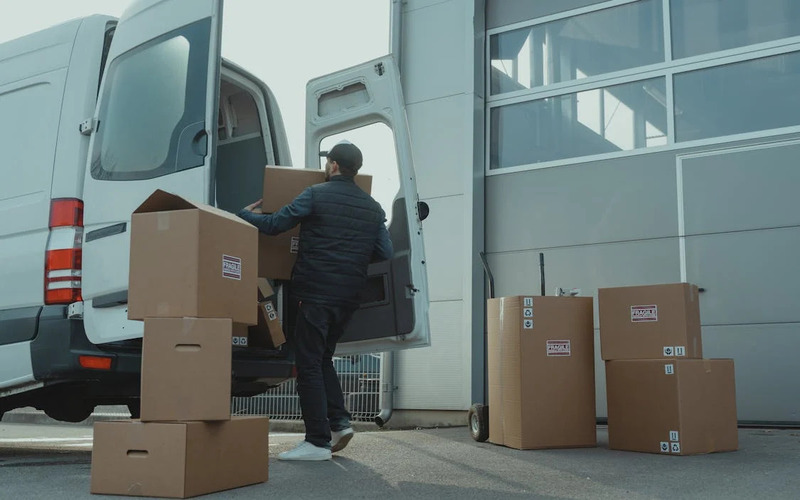
Preparing for Peak Holiday Season [A Guide for Sellers]
The peak holiday season is the most critical time of the year for e-commerce businesses, characterized by intense order volumes, high consumer expectations, and operational complexities.

Up to 64% Lower Returns Processing Cost

Amazon’s One-Day Shipping: The Real Story for Retailers
In this article
If Amazon owns nearly half of the $513 billion U.S. ecommerce market, why the need to offer one-day free delivery? The key to this decision is Amazon’s singular obsession with customer centricity and an appreciation for indirect results that don’t even register on the radar of some competitors.
If Amazon owns nearly half of the $513 billion U.S. ecommerce market, why the need to offer one-day free delivery? The key to this decision is Amazon’s singular obsession with customer centricity and an appreciation for indirect results that don’t even register on the radar of some competitors.
Insights abound for those able to get past the headlines. Here are three of the most important takeaways that were either overlooked or under-covered in the media frenzy.
- Rock the Customer Experience or Die
- ROI Needs a Radical Rethink
- Double Down on Innovation, Play to Your Strengths
With the expenses involved in offering free shipping, it’s not hard to see why Amazon’s annual shipping bill is set to exceed $7 billion dollars according to the latest estimates. Retailers often opt to pass these costs on to their customers or offer ecommerce order fulfillment options that won’t leave them substantially in the red, but they’re missing the point.
Offer 1-day and 2-day shipping at ground rates or less.
Recent Blog Posts

Packaging Design That Will Make Fulfillment Easy and Cut Costs
E-commerce Revolution with Strategic Packaging Solutions Like anyone in the e-commerce world, small business owners are always looking for ways to streamline their operations and

USPS Hazmat Shipping Guidelines – How to Ship Fast While Staying Compliant
Hazardous Materials What is a Hazardous Material? What Items Are HAZMAT? Classes of HAZMAT Items What Classes Can Ship on Various USPS Services? What Changes

Protect Your Amazon Listings from Search Suppression, Hijackers, and Stockouts
Amazon is a competitive platform. You need to have a quality product, excellent listing content, and plenty of reviews to catch the attention of busy
Shippers Beware: New USPS Dimensional Pricing Coming June 23
In this article
The second phase of the United States Postal Service changes kicks in on June 23, 2019. USPS is changing the way it charges for boxes shipped via Priority Mail, Priority Mail Express as well as new international weight limitations. Currently, USPS applies a dimensional divisor (DIM) of 194 for boxes that exceed one cubic foot in volume, and DIM only applies to zones 5 and above. Starting June 23, 2019, the DIM divisor will be reduced to 166 and will apply to ALL zones (local and 1-9) for Priority Mail, Priority Mail Express and Parcel Select.
The second phase of the United States Postal Service changes kicks in on June 23, 2019. USPS is changing the way it charges for boxes shipped via Priority Mail, Priority Mail Express as well as new international weight limitations. Currently, USPS applies a dimensional divisor (DIM) of 194 for boxes that exceed one cubic foot in volume, and DIM only applies to zones 5 and above. Starting June 23, 2019, the DIM divisor will be reduced to 166 and will apply to ALL zones (local and 1-9) for Priority Mail, Priority Mail Express and Parcel Select.
The first phase of USPS rate hike went into effect in January earlier this year.
Retailers doing order fulfillment must also provide dimensions when the package cubic volume measures over one cubic foot (1,728 inches) while generating labels. Shippers are also encouraged to provide dimensions for all packages and allow for configurable dim divisors to support future changes. Negotiated Service Agreements (NSAs) will be allowed to have a configurable dim divisor for each Zone at this present time.
If you are a USPS shipper, this will impact you. Let’s see this via the following example.
|
Dimensions |
Old Price |
New Price (effective June 23) |
Price Increase |
|---|---|---|---|
|
15 x 12 x 10 |
10 Pounds (194 DIM) = $26.85* |
11 Pounds (166 DIM) = $29.00* |
$2.15 (8% INCREASE) |
*Priority Mail Retail Rates to Zone 5
While the DIM change from 194 to 166 will certainly impact some postal shippers, it’s important to know that the Postal Service will continue to apply actual weight for packages that don’t exceed one cubic foot in volume. That is, if the cubic volume of a box doesn’t exceed 1728 inches, the charge will continue to be based on the actual weight (not DIM weight).
That’s not all. The Postal Service will also revise the weight limitation for First-Class Mail International (FCMI) flat pieces to 15.994 oz. to more closely align the definition of FCMI large envelopes (flats) with that of the Universal Postal Union Conventions.
For FCMI flats that are over 15.994 oz., USPS will not process those as FCMI starting June 23, instead, you will need to classify and mail those pieces under First-Class Package International Service (FCPIS).
You could alternatively elect to use another class of mail such as Priority Mail Express International or Priority Mail International, if the mail piece meets the requirements for those mail classes.
Below are few strategies for offsetting the impact of the new DIM billing:
1. Move package volume from USPS to FedEx/UPS or other parcel carriers. High-volume shippers can negotiate deeper discounts and more favorable DIM divisors. Many regional carriers offer shipper-friendly DIM divisors compared to the large national carriers. The large national carriers right now may be more open to offering special incentives to shippers as they try to offset the loss of business from Amazon.
2. Try to get commercial base pricing (CBP) or commercial plus pricing (CPP). Most Cahoot merchants qualify for special CBP and CPP pricing; please contact us if you are not enjoying these rates already. High-volume shippers can get even deeper discounts by pursuing a negotiated services agreement (NSA) with the Postal Service or through authorized postal resellers. These discounts could offset DIM increases, at least in the short-term.
3. Improve packaging. By reducing excess box dimensions and minimizing fill, shippers can reduce the impact of dimensional pricing, reduce corrugated and packing material costs, and reduce carbon emissions.
4. Optimize via Cahoot. By joining Cahoot’s innovative peer-to-peer ecommerce order fulfillment networkTM, you can convert say a zone 8 shipment to a zone 2 shipment. You save big which more than makes up for any DIM billing increase, plus the packages get delivered to your customers faster.
If you haven’t yet considered the impact of the upcoming June 23 changes, you could be looking at an 8 percent-plus increase on some or more of your USPS packages. Please contact a Cahoot Expert, if you need help or would like to learn more.
Offer 1-day and 2-day shipping at ground rates or less.
Related Blog Posts

Packaging Design That Will Make Fulfillment Easy and Cut Costs
E-commerce Revolution with Strategic Packaging Solutions Like anyone in the e-commerce world, small business owners are always looking for ways to streamline their operations

USPS Hazmat Shipping Guidelines – How to Ship Fast While Staying Compliant
Hazardous Materials What is a Hazardous Material? What Items Are HAZMAT? Classes of HAZMAT Items What Classes Can Ship on Various USPS Services?

Protect Your Amazon Listings from Search Suppression, Hijackers, and Stockouts
Amazon is a competitive platform. You need to have a quality product, excellent listing content, and plenty of reviews to catch the attention of busy consumers
Coopetition is Disrupting Ecommerce Order Fulfillment
In this article
 23 minutes
23 minutes
Coopetition is the act of cooperation between competing companies with partial congruence of interests to gain advantage by cooperation and generating more value by working together.
Coopetition is the act of cooperation between competing companies with partial congruence of interests to gain advantage by cooperation and generating more value by working together.
Amazon makes up most of the US ecommerce sales. However, they rely heavily on 3rd party sellers. These sellers experience major pain related to ecommerce order fulfillment cost and time. It can be a challenge to meet the fast shipping demands of customers with 1-day and 2-day shipping costs nationwide cutting deep into profits.
Fast shipping is now an expectation, but it is expensive for most sellers. Sellers often limit fast shipping to very small items or to local addresses. This limits their Amazon buy box opportunities.
This presentation highlights how Sellers can save time and money on shipping by using strategic coopetition – a concept that has been around for centuries
Coopetion in Ecommerce Order Fulfillment from Cahoot Ecommerce Fulfillment
ANCIENT ROME HAD A LENDING PROBLEM
Rome offers a great example of coopetition strategy. Once upon a time around 3rd Century BC, Roman Empire was immensely extended.
At this time, the 4 most lucrative business activities were: renting buildings, agriculture, lending money and maritime trade. The two last activities were closely linked because in order to engage in a trading business, one needed capital, which meant the need for borrowing money. Transport of goods on land for more than tens of kilometers were not feasible because of high costs and the material conditions to mobilize. Trade (especially maritime trade) had greatly contributed to the development of Rome and its Empire.
During this period of Roman antiquity, the organization of trade was significantly similar to ours, with mostly small businesses. Profession of maritime merchant at this time could be defined as a wholesaler activity. First, they had to purchase goods to sell it afterwards, hence the need to borrow money
But, long distance trade suffered from lack of information until the invention of telegraph. There was uncertainty all along the journey because no information was transmitted until goods’ final delivery. Hence, Landlords didn’t practice long distance trade, they sold their own products to local merchants who exported it afterwards. These merchants operated free markets and were in competition locally because “when several merchants sell the same products in the same area and there is formation of prices, there is competition”
Rich senators and landlords divided their wealth in two activities, on the one hand agriculture and on the other hand individual loans. Lending money was a very profitable activity and maritime loan was the most profitable but riskier. Its reimbursement rate was very low because of a very high level of defection, scams and many malice acts during Republic times. Being a landlord was honorable whereas being a merchant wasn’t. Tradespeople suffered from a very bad reputation. This resulted in a major lending problem at the time.
Around the 3rd century BC, a rich landlord and a senator by the name of Caton, wanted to diversify his investments, and wanted to have more lucrative loans by mitigating his risks. So, he invented a concept of collective loan. To ensure reimbursement of loans, Caton asked his borrowers (the merchants in this case) to form an association. They had to create a society by assembling enough colleagues to gather fifty merchants and fifty ships. He would then loan the money to the group instead of an individual member. Caton allocated loans to a large number of ships, thereby reducing the risks of maritime incidents. He started the activity of collective maritime loan, comparable to modern concept of microcredit. This society worked following a principle of auto-selection and auto-management. Borrowers were therefore linked together and each had a part of responsibility, which established a social pressure on them. So, the merchants cooperated, via this common association. This collective loan had a fixed and high rate. This didn’t only decrease maritime risks, but also the one linked to borrowers’ disloyalty.
These loans allowed merchants to purchase goods, then they repaid it after having sold these goods. Collective loan is the first activity of collaboration between merchants during maritime trade process.
After having purchased their goods, merchants cooperated on another activity: sea freight. Acts of fraud and piracy occurred very often during Roman Republic, and also loss of goods due to weather related hazards. A shipwreck represented a terrible economic loss.
Facing these uncertainties related to navigation conditions and to avoid the complete loss of goods, merchants divided their total quantity of goods on various ships. This divided risks of loss of cargos due to maritime incidents or deliberates acts.
Second, transport of goods by sea were long and expensive. The higher the tonnage was and the cheaper the freight was, which motivated the merchants to fill boats for deliveries by joining forces. It was possible to rent space on a boat of another competing merchant. It did not make financial sense for each merchant to send ships with sub-optimal load to the same destination, hence these competing merchants came together to follow the “common freight for a journey” principle which was win-win for all of them.
With many owners for the same freight, risks were divided; the effect is the same as the one about the association imposed by Caton to his borrowers. It is an act of safety which needs many actors and transactions.
Romans combined cooperative and competitive activities in the trading process:
- In the first activity of the value chain, to get collective loan, merchants cooperated via an association asked by the lender (Caton). Cooperation was not only informal but was institutional. Merchants were linked together via the association’s management, which imposed to them a social pressure, diminishing loan default risks.
- Once funding is obtained, in the second activity of the value chain, merchants were rivals to purchase goods from suppliers at the best price. Loan obtained collectively allowed them to purchase goods individually, without any form of cooperation.
- Into the third activity of the value chain, related to ship freight, merchants cooperated to minimize risks of cargos’ loss due to sea accidents or deliberate acts of piracy. Social pressure stayed strong but wasn’t institutionalized as for collective loan. This was the result of merchants’ deliberate strategy due to strong economies of scale in this activity of the value chain. Transportation costs greatly decreased when cargos’ burden increased, which made collective freight very profitable.
- For the last activity of the value chain, once goods arrived at their destination, merchants ended any form of cooperation and sold their goods individually. Rivalry was very strong to sell their goods to the same consumers.
HIGH TIDE LIFTS ALL BOATS
The entire system benefitted:
- Commerce was a major driver of the Roman Empire and of wealth
- Maritime commerce one of the most profitable forms of commerce
- As coopetition increased the maritime merchants position improved, and so did the Empire’s.
WHAT IS COOPETITION
Coopetition is the act of cooperation between competing companies with similar interests to gain advantage by cooperation with the goal of generating more value by working together compared to the value created without interaction.
Coopetition is “the dyadic and paradoxical relationship that emerges when two firms cooperate in some activities, such as in a strategic alliance, and at the same time compete with each other in other activities” (Bengtsson and Kock, 2000, p. 412).
Think of it as “firms collaborating in order to increase the size of the business pie, and then compete to divide it up.”
Roman merchants used coopetition since the beginning of the 3rd century BC. Hence, Coopetition is not a modern strategy driven by the double race to globalization and technology, which began at the beginning of the 1980’s. However, many major examples of coopetition are identified from the 1950’s. Driven by public policies in Japan, and in Europe, coopetition is responsible for many industrial successes.
STRATEGIC COOPETITION BENEFITS
Grow Current Markets
In 2004, rivals Sony and Samsung joined forces to build a LCD manufacturing facility in South Korea in order to better compete against LG and Phillips. Partly because of the new factory, the average price for LCD televisions that are 40 inches or larger fell from about $8,000 to $1,500
Gain Resource Efficiency
Formed in 1997, Star Alliance now counts over 27 airlines as partners and serves over 640 million passengers each year. One of the biggest benefits of STAR ALLIANCE is codesharing. Using this arrangement, two or more airlines are able to sell the same flight using the same code. Codesharing reduces the costs associated with operating underbooked flights while it increases the visibility of an airline who is able to boast multiple routes worldwide despite not actually operating them. Increased scale allows partner airlines to gain efficiency and access to complementary assets.
ECOMMERCE ORDER FULFILLMENT PROBLEM
Fast shipping is the expectation, but fast shipping is expensive.
COOPETITION STRATEGY IN ACTION
Changing Dynamics of the Parcel Shipping Industry
- Explosion in parcel volume due to e-commerce
- Relationship between the players in the market is changing
- Coopetition is leading to a “win-win” situation
USPS Core Strengths
- “Last mile” connectivity
- Literally touches every doorstep, 153M delivery points
- Processing and handling capabilities that excel at smaller packages (< 5 lbs.)
- Low marginal delivery costs
UPS Core Strengths
- Highly automated distribution hubs that include larger vehicles, rail and airplane
- Superior routing logistics for large package transport
- Efficient airport-to-airport delivery
- Lower per unit upstream cost
Scope
- UPS picks up a package from the warehouse or distribution center and moves it through the UPS parcel network
- UPS delivers package to USPS for the “last mile” delivery to a residential address
Coopetition Results
- UPS and USPS share the revenue
- Increased market share and revenue
- Lower cost from optimized distribution efficiency
- Lower delivery charges for customers
- Improved customer service
- Sustainability and lower CO2 emissions
COOPETITION RISKS AND BENEFITS
Whether you are familiar or not with the term, you’ve likely seen examples of coopetition in the news in some form or another. But of course, in these sort of deals, when two large competitors who first and foremost are looking to protect their own interests partner up, conflict happens. In fact, coopetition arrangements between larger competitors are often temporary…
COOPETITION REQUIREMENTS
- But the best, most successful, most sustainable coopetition arrangements – where you aren’t starting and restarting or terminating permanently – nearly always happen when then participants/stakeholders are looking to achieve something greater then themselves. Something greater than their own individual profits, or their combined benefits.
- A large external north star provides a guiding light for partners so that they don’t have to spend time, arguing over which priorities are most important. Or spend energy and resources focused on protecting themselves within the partnerships. A big bright, north star keeps them aligned on the same path for the long-term.
MLS
“And sometimes, competitors come together to change the way an entire industry operates. Back in the 1800’s, U.S. real estate agents began to create multiple listing services. Essentially, they paid into a listing service that allowed agents to see information regarding potential deals represented by competing agents. And agents received additional commissions for helping one another out. The approach allowed even the smallest firms to compete on the same footing as industry behemoths.
- Sometimes, come together to change how entire industry operates
- 1800’s: US RE agents create multiple listing services: “Realtors would meet at the offices of their local association and share with one another information about the properties they were trying to sell.”
- Paid into a listing service that shared deal info of competing agents
- Shared commissions
- Fundamental principal: “Help me sell my inventory and I’ll help you sell yours.”
- Smallest firms can compete on same level as industry behemoths.
Increase probability of long-term coopetition success:
- information is shared
- constant communication is present
- participants feel they can continuously learn
- information used to collectively adjust to external environment
In fact, MLS’s are still used today, even in the modern information age. Making the market liquid, helping agents earn their keep, and making easier for average citizen to buy into the American dream.
Governance
This case of Roman merchants during Antiquity also shed light on contractual forms of coopetition. Cooperation to get loan is an example of institutionalized coopetition through creation of an association by borrowers, driven by the lender (Caton). We find here an example of coopetition imposed by a third actor, as it could be possible in our contemporary period.
This actor plays a role of initiator and manager of coopetition. Structured management by the third actor appears as a tool and ensures good performance of implemented coopetition strategy.
Size of firms involved in coopetition is another interesting element of discussion. Coopetition in antic maritime trade appears in small business context. This contradicts the commonly shared idea by researchers that coopetition appeared first in big companies, in order to increase their power
- Another way to play this game. The Roman way. And coopetition works even better when things are set up so that many direct stakeholders benefit along the way.
- Often times, a collection of small businesses will use this way of coopetition to forward their collective interests in an entire region, market, or industry.
Constant data communication: Knowledge sharing/transfer/creation à competitive information asymmetry
Constant communication facilitates learning, opportunities, and trust
Data: A shared measurement system; Adapt to data
Backbone: Aware potential stakeholder synergies and power dynamics.
Proactive facilitator of stakeholder relationships and resources. Oversight of network performance, environmental risk.
Learning: Each partner believes it can learn from the other. Continuous and dynamic process that adjust to environment and helps participants evolve.
This brings up another point in putting together strategic coopetition arrangements. An arrangement where information is shared, constant communication is present, and where participants feel they can continuously learn from the experience greatly increases the probable long-term success of a coopetition agreement. Doubly so when information can be used to help the participants collectively adjust to any threats or changes in the external environment.”
Is Coopetition worth the trouble?
But is this really possible in today’s day and age? Why would two dominate forces look to spend resources to pursue benefits that are achieved beyond themselves?
The Big Reservation
- And, inevitably, at this point, a few will have a very specific reservation. It’s usually the small business owner. The man or woman who has owned their business for 2, 5, maybe 20 years, and is worried about supporting their employees and surviving as they compete against companies many times their size. They’ll say something like…
- Does coopetition really mean a few large companies orchestrate some way to grow the entire pie, and then have an even larger share of it? How can I be sure I benefit?
- Or in other words, do these big companies tout cooperation as something everybody benefits from, but really they operate in the same old way of doing business.
Yara Coopetition
We’ll take a broad look at how two very different companies—the Norway-based manufacturer Yara and the retail giant Walmart—have used collective-impact principles to improve their ecosystems for all concerned.
Yara is a global leader in fertilizer manufacturing based in Norway. It faced numerous obstacles in its effort to reach small African farmers from its port of entry in Tanzania. Yara’s Fertilizer had the potential to increase crop yields in the famine-afflicted country. But corruption in the government-controlled port delayed the unloading of shipments for many months. Roads were inadequate for transporting the fertilizer to farms and the produce back to the port; a third of the harvest was typically left to rot for lack of refrigerated transport. Farmers were poor, often illiterate, and unaccustomed to using fertilizer; they also lacked access to credit. A government ban on the export of key crops, meant to protect local consumption, had the unintended consequence of shrinking the market and curbing capital investment.
All this added up to a classic market failure that propagated famine and poverty and also curtailed Yara’s growth. The problem was deeply entrenched: The farmers had little power to influence government policy, and they were suspicious of any changes to their traditional methods. International aid temporarily alleviated hunger but left the underlying issues untouched. No single intervention could prevail; success required that all the interrelated obstacles be addressed at once.
Starting in October 2009, Yara worked to bring together 68 organizations, including multinational companies, civil society groups, international aid agencies, and the Tanzanian government, in a partnership known as the Southern Agricultural Growth Corridor of Tanzania (SAGCOT). The mission was to build a $3.4 billion fully developed agricultural corridor from the Indian Ocean to the country’s western border, covering an area the size of Italy. It involved investing in infrastructure, including the port, a fertilizer terminal, roads, rail, and electricity; fostering better-managed farmer cooperatives; bringing in agro dealers and financial services providers; and supporting agro-processing facilities and transport services. Public sources have provided one-third of SAGCOT’s funding; the rest comes from the participating private enterprises. Although originally envisioned as a 20-year project, the corridor was well established within 3 years and has already bolstered the incomes of hundreds of thousands of farmers. Yara was decisive in launching the effort but did not lead or control it. Nor was the company’s investment—$60 million—a major part of the funding. Yet the project has boosted Yara’s sales in the region by 50% and increased the company’s EBITDA by 42%.
Walmart Coopetition
Societal constraints are not limited to emerging markets, of course.
In 2012, as Walmart was working to reduce its packaging costs by eliminating 20 million tons of greenhouse gas emissions from its supply chain and, it encountered an unexpected roadblock: Its suppliers could not source enough recycled plastic to use in their packaging. It turned out that 45% of the U.S. population lived in cities that were still dumping trash in landfills. Even though recycling would have yielded significant new revenues and savings, cash-strapped municipalities could not afford the up-front investment required for collection and sorting equipment and for campaigns to change consumer behavior. So in April 2013 Walmart, like Yara, convened a cross-sector coalition of NGOs, city managers, recyclers, major consumer brand companies (including direct competitors such as Unilever and P&G), and financing experts from Goldman Sachs. Many of the participants had spent years trying to launch their own recycling programs; by the time they met, all recognized that the problem could be solved only by collectively addressing the challenge of financing municipal curbside recycling.
Together, 10 companies invested in the $100 million Closed Loop Fund, whose purpose is to promote investments in recycling infrastructure across the United States. It is governed by an independent committee of experts in finance, the environment, recycling, supply chain, and municipal management.
To date the fund has financed 10 projects. As the result of one project, every household in Memphis, Tennessee—a city that had no curbside recycling whatsoever—now has access to convenient recycling carts. These 10 projects alone are expected to reduce annual waste to landfill by more than 800,000 tons and cut greenhouse gas emissions by more than 250,000 tons while creating hundreds of jobs.
And the benefits to Walmart are considerable: The increased availability of recycled materials strengthens its supply chain and reduces the cost of packaging. Again like Yara, Walmart neither led nor controlled its cross-sector effort—but it provided the necessary impetus.
A SOLUTION FOR ALL
So at this point, you should have some sense of not only what strategic coopetition means, but when done right, what it can achieve for those who decide to participate. It’s generally, at this point, when I can get people to understand the true power of coopetition, that people get excited. They began to think about ways to leverage this approach for the benefit of their own businesses, or problems they know everyone in their industry or neighborhood are facing.
GREED IS GOOD
In the words of Gordon Gekko, “Greed, for lack of a better word, is good.” Greed is a clean drive that “captures the essence of the evolutionary spirit. Greed, in all of its forms; greed for life, for money, for love, knowledge has marked the upward surge of mankind.” If the first caveman didn’t greedily want cooked meat and a warm cave, he never would have bothered to figure out how to start a fire.
BUT, GOOD IS BETTER
The problem with greed however is that it’s a zero sum game; somebody wins, somebody loses. Money itself isn’t lost or made as Gekko said; it’s simply transferred.”
The goal of strategic coopetition on the other hand is to increase the size of the pie, such that all the players reap the benefits proportionately.
THE NEW WAY WORKS BEST
The Power of Many: Coopetition Examples
There’s another way to play this game. The Roman way, if you like. Coopetition works even better when things are set up so that many direct stakeholders benefit along the way. Often times, a collection of small businesses will use this way of coopetition to forward their collective interests in an entire region, market, or industry.
Porto Alegre Beer: For example, in the Porto Alegre region of Brazil, local microbreweries very much did as the Romans. They worked together to collectively purchase and distribute goods to lower costs and achieve scale in making and delivering their products. They went one step forward, creating formal and informal associations that worked together to successfully position Porto Alegre beers as premium products. [5 small firms producing specialty beers located in the Anchieta neighborhood in the city of Porto Alegre, Brazil work together to forward local microbrewery market. Initiatives include purchasing and distribiution. à This all seemed to happen fairly recently, in the 2000’s/2010’s. Led to revitalization of local neighborhood.]
California Dairy: In the United States, dairy farmers across California collectively invested in shared advertising campaigns to further penetrate their collective markets.
Pic Saint Loop Wine: French wineries in the Pic Saint Loup region did same in an even more organized fashion, running creating one organization that successfully position Pic Saint Loup wines as premium brands and grew their collective market in the process. [Informal community to exchange practices and resources. guided by a proactive economic effort: the positioning in a niche for “premium” wines. Decided to found a collective brand in order to follow their individual strategies. Thus, the winemakers of Pic Saint-Loup took part in a global movement to launch a collective brand. The collective brand supports a coopetition strategy based on quality improvement of the products. The relationships between the members, the rules of production and the union were formalized.
BIG CHALLENGES REQUIRE EVOLVED THINKING
In the past, companies rarely perceived themselves as agents of social change. Yet the connection between social progress and business success is increasingly clear. For example: The first large-scale program to diagnose and treat HIV/AIDS in South Africa was introduced by the global mining company Anglo American to protect its workforce and reduce absenteeism. The €76 billion Italian energy company Enel now generates 45% of its power from renewable and carbon-neutral energy sources, preventing 92 million tons of CO2 emissions annually. And MasterCard has brought mobile-banking technology to more than 200 million people in developing countries who previously lacked access to financial services.
If business could stimulate social progress in every region of the globe, poverty, pollution, and disease would decline and corporate profits would rise. In recent years creating shared value—pursuing financial success in a way that also yields societal benefits—has become an imperative for corporations, for two reasons. The legitimacy of business has been sharply called into question, with companies seen as prospering at the expense of the broader community. At the same time, many of the world’s problems, from income inequality to climate change, from childhood obesity to human trafficking, are so far-reaching that solutions require us to combine our expertise and resources and evolve our way of thinking.
But even as corporations pursue shared value strategies, businesses inevitably face barriers at many turns. No company operates in isolation; each exists in an ecosystem where societal conditions may curtail its markets and restrict the productivity of its suppliers and distributors. Government policies present their own limitations, and cultural norms also influence demand.
These conditions are beyond the control of any company. To advance shared value efforts, businesses must foster and participate in multisector coalitions—and for that they need a new framework. Strategic coopetition is one such framework. Companies that embrace such new frameworks will not only advance social progress but also find economic opportunities that their competitors miss.
Learn more about how you can leverage the power of coopetition. Offer 1-day and 2-day shipping at ground rates or less. Drive
down your shipping costs, delight your customers, and scale as big as you want.
Offer 1-day and 2-day shipping at ground rates or less.
Related Blog Posts

Packaging Design That Will Make Fulfillment Easy and Cut Costs
E-commerce Revolution with Strategic Packaging Solutions Like anyone in the e-commerce world, small business owners are always looking for ways to streamline their operations

USPS Hazmat Shipping Guidelines – How to Ship Fast While Staying Compliant
Hazardous Materials What is a Hazardous Material? What Items Are HAZMAT? Classes of HAZMAT Items What Classes Can Ship on Various USPS Services?

Protect Your Amazon Listings from Search Suppression, Hijackers, and Stockouts
Amazon is a competitive platform. You need to have a quality product, excellent listing content, and plenty of reviews to catch the attention of busy consumers

Up to 64% Lower Returns Processing Cost

Overcoming FBA Restrictions with Agile Fulfillment
In this article
 10 minutes
10 minutes
Agile ecommerce order fulfillment alternatives to make the switch to FBM
Amazon Sellers are Awash with Disruptions
Last week the Amazon FBA (Fulfilled by Amazon) community was shaken by Amazon’s decision to restrict the kinds of inventory it’s receiving until April 5, 2020. Shipments of inventory turned away, and many FBA sellers left to fend for themselves amid the crisis. Many sellers who still have FBA inventory are panicking after seeing delivery dates pushed to April, and some items would even take a month to deliver. Many voiced concerns about losing an entire month of sales.
2021 Update: To learn about the latest FBA restrictions and to discover how to mitigate risk and maximize Amazon sales in Q4 and beyond, check our article and on-demand webinar on How To Improve Your IPI Score & Maximize Amazon Sales
Amazon SFP Sellers are Also Hitting Bumps
As merchants rush to convert their listings to Fulfilled by Merchant (FBM), some merchants on the Cahoot Order Fulfillment Network have reported that Amazon has started assigning weekend delivery dates to some Seller Fulfilled Prime (SFP) orders. It’s unclear at this time as to the reasons or which orders or merchants are impacted. One example is a medical supply Cahoot merchant in California. The merchant received several prime orders with a Saturday delivery deadline. Unfortunately, the only delivery option available through Amazon for the deadline was a $120 one-day air service for a $40 item. This is most likely a glitch in Amazon systems. Still, Sellers must fulfill these orders using expensive overnight shipping to maintain their good standing with Amazon or risk losing the SFP selling privileges.
Agile Ecommerce Order Fulfillment is the Present and the Future
COVID-19 situation has exposed a fundamental flaw of over-reliance on a single fulfillment channel. Just like an investor would diversify its portfolio between multiple asset classes, Amazon Sellers should not rely exclusively on FBA for their order fulfillment. There are order fulfillment options that are within your reach, and some of them can even be set up and running in a matter of days.
At Cahoot, we believe in agile order fulfillment that can quickly adapt to changes. Agile fulfillment requires three parts: (1) Flexibility, (2) Resilience, and (3) Scalability. Flexibility implies fulfillment that follows the money, so you can quickly adapt and make changes—for example, quickly adding order fulfillment capabilities in regions where demand is concentrated. If you get a surge of orders from California, having a fulfillment option regional or local to in California would help you lower shipping costs while speeding up deliveries. Flexibility also means the ability to shift fulfillment locations when demand patterns change naturally or as a result of new sales channels or marketing campaigns.
Resilience in ecommerce order fulfillment means making sure your pick, pack, and ship operations continue during disruptions. Major events like the Amazon FBA restriction won’t bring your business down if you have redundant fulfillment capabilities.
Scalability means ensuring your order fulfillment capacity can scale to support your business’ growth and downturn. Having multiple fulfillment options and the technologies that tie them all together can minimize disruptions as your business grow. The aim here is to right-size your operations to suit your business demands while optimizing costs
4 Order Fulfillment Alternatives for Amazon Sellers
Below are 4 popular agile order fulfillment options for sellers to consider.
Own Warehouse
Setting up order fulfillment operations within your own warehouse could be a reasonable stop-gap measure if you have the systems, supplies, and staff. This is a good redundancy strategy to continue selling if FBA goods ever go out of stock.
However, continuing to do order fulfillment using a single fulfillment center is unsustainable when compared to the cost and speed of FBA. Fulfilling 1-day or 2-day delivery prime orders from a single location is very costly. A guaranteed next-day express shipping service is four times the cost of an economical ground shipping.
Pros:
- Suitable for a temporary back-up option for FBA
- At full capacity utilization, order fulfillment can be very economical
- Complete control over your operations and full flexibility in how you package your items
Cons:
- Requires considerable time and resources to find, train and manage staff and day-to-day operations
- Limited coverage via Ground service to deliver orders within 1-Day and 2-Day
- Reaching and maintaining full capacity utilization year-round is very hard
- May not be suitable for Amazon orders if the Operations are brand new which can lead to unacceptance fulfillment defect rates
3PL (Third Party Logistics)
3PLs can provide flexibility by allowing you to add order fulfillment locations faster than building your own warehouses. Smaller 3PLs may be willing to offer lower prices to compensate for their limited coverage.
Smaller 3PLs are a good choice if you already have your own order fulfillment operations and are only looking for a new location to have better two-day ground coverage. Smaller 3PLs are often mom-and-pop operations with limited technology and capacity. Hence, limited in scalability. If you’re looking to offer free one- or two-day shipping across the U.S., working strictly with small 3PLs can be complicated. It may require working with multiple companies, integrating all of their systems to yours, and maintaining them regularly. Plus, you will not have the flexibility to re-calibrate your fulfillment in response to changing customer demand patterns. And, you will be impacted if your single 3PL site has to shut down or downsize their operations for whatever reason.
Pros:
- Add new locations to complement your own order fulfillment
- Access to discounted freight and parcel shipping rates negotiated by the 3PL
- Supports multichannel order fulfillment
Cons:
- Limited capacity and flexibility. They often require long-term contracts with a minimum volume commitment for favorable pricing.
- Limited technology to provide real-time visibility and intelligence into the orders and fulfillment
- Difficult to reliably achieve economical 1 or 2-day delivery nationwide.
- Support for Seller-Fulfilled Prime orders may be limited due to demanding SLAs and special requirements
On-Demand Warehousing
On-demand warehousing or 4PLs (Fourth Party Logistic Model) are services that manage multiple 3PLs so merchants can quickly add warehouses as needed. They help merchants find new warehouses that fit their location, timing, or special handling needs (e.g., hazmat, temperature-controlled, perishables, to name a few). Companies such as Flexe, Flowspace, and Ware2Go are platforms that connect 3PLs who have excess storage space with sellers who need them. 4PLs make it simpler for merchants to work with multiple 3PLs because merchants only need to integrate with the 4PL and have the flexibility of short-term space rentals (instead of the long-term commitment typically required by 3PLs).
4PLs generally provide customer support and additional services such as receiving inbound shipments, storage, pick-and-pack, and outbound shipping. But through multiple facilities in distributed geography instead of just one.
Like 3PLs above, merchants need to make sure the 3PLs they are working with are capable of offering 1-day or 2-day delivery nationwide. Not all 4PLs are geared toward fast and cost-effective B2C e-commerce order fulfillment as some tend to specialize in services such as bulk store replenishments, short-term storage facilities, or FBA inventory prep. Because 4PLs are primarily selling 3PL storage and fulfillment services, sellers have to figure out how to optimize their overall costs and business operations by themselves.
Pros:
- Only pay for warehouse space you need without the long-term commitment.
- Minimize complexity from integrating with multiple 3PLs to just one 4PL
- Storage fees may be cheaper than conventional 3PL models because warehouses on the platform mostly list their unused space.
- Supports multichannel orders
Cons:
- Does not specialize in Amazon eCommerce order fulfillment.
- Support for nationwide Amazon Seller-Fulfilled Prime (SFP) fulfillment could be unpredictable, where the performance metrics are very demanding and there is little to no room for errors.
- Space availability varies frequently and dependent on the 3PL partners who are simultaneously servicing their own clients and other platforms.
- Potentially more expensive than a traditional 3PL for eCommerce order fulfillment because both the warehouse and the platform need to make money.
Peer-to-Peer Order FulfillmentTM
Services like Cahoot offer Peer-to-Peer eCommerce Order fulfillmentTM, which is a hybrid between in-house fulfillment and 3PLs. It combines the flexibility and reach of a 4PL with the cost efficiency of in-house fulfillment. In the peer-to-peer model, ecommerce sellers exchange warehouse space and fulfillment services. Under this model, merchants who currently do their own order fulfillment can now work together in a coalition and offer free and fast shipping to each others’ customers wherever they may be located.
Peer–to–peer model offers the most agile order fulfillment because it connects ecommerce sellers to a network of trusted peers, thereby creating a very large network.
First, it provides unparalleled flexibility because online retailers can quickly and easily re-calibrate their fulfillment strategy and locations in response to their inventory demand graph as opposed to serving all customer orders from a fixed fulfillment configuration. This enables Amazon sellers to win the buy box more often and without undue compromise to their margins.
Second, it provides resilience because online sellers collaborate with multiple geographically distributed fulfillment nodes simultaneously on a large-scale global network. So if one partner falters, the merchant can still continue their operations without any business disruption.
Third, peer-to-peer order fulfillment provides high scalability due to the sheer number of high-performing members on the network who each has varying scales of warehouse capacity and resources.
Peer-to-peer’s workshare model allows for the lowest overall storage and order fulfillment costs compared to other options.It takes mere days to start having your stuff fulfilled through Cahoot, and you can get shipping in no time. To learn more or get started, contact us today.
Pros:
- Peer-to-peer gives brands and retailers access to the widest range of ecommerce order fulfillment locations, both domestic and international.
- Overall storage and fulfillment fees are the lowest because of its unique “workshare” model.
- Works with other merchants of repute who have a proven record of handling fast same-day SFP orders and defect-free operations.
- Scales easily and cost-effectively to support the most demanding SLAs
Cons:
- Not always a solution for newer merchants as acceptance into the network requires a proven track record of high-performance fulfillment that can be verified
- Does not offer custom branding or packaging inserts currently.
- Merchants may need to arrange for inbound freight to the receiving warehouses.
- Not suitable for drop-ship merchants or ones who carry just-in-time inventory.
Offer 1-day and 2-day shipping at ground rates or less.
Related Blog Posts

Packaging Design That Will Make Fulfillment Easy and Cut Costs
E-commerce Revolution with Strategic Packaging Solutions Like anyone in the e-commerce world, small business owners are always looking for ways to streamline their operations

USPS Hazmat Shipping Guidelines – How to Ship Fast While Staying Compliant
Hazardous Materials What is a Hazardous Material? What Items Are HAZMAT? Classes of HAZMAT Items What Classes Can Ship on Various USPS Services?

Protect Your Amazon Listings from Search Suppression, Hijackers, and Stockouts
Amazon is a competitive platform. You need to have a quality product, excellent listing content, and plenty of reviews to catch the attention of busy consumers

Up to 64% Lower Returns Processing Cost

Packaging Design That Will Make Fulfillment Easy and Cut Costs
Like anyone in the ecommerce world, small business owners are always looking for ways to streamline their operations and enhance the customer experience. A critical aspect that often gets overlooked is packaging design. It’s not just about making products look attractive; it’s about making smart, cost-effective choices that simplify the order fulfillment process and reduce packaging costs. This article will delve into innovative strategies that ecommerce businesses can employ to revolutionize their packaging approach, ultimately cutting down on supply chain expenses and boosting customer satisfaction.
Understanding the Impact of Packaging Materials Choices
The type of packaging chosen plays a pivotal role in the overall success of any ecommerce business. Whether it’s a sturdy cardboard box, a sleek mailer, or eco-friendly packaging, each element contributes significantly to the brand identity and customer unboxing experience. However, beyond the aesthetics, smart packaging design is about optimization and cost savings. It’s about selecting box sizes and packaging materials that not only protect products but also reduce shipping costs and carbon footprint, while shipping safely and efficiently.
What is Dunnage?
Dunnage is a crucial component in the shipping and logistics industry, playing a vital role in ensuring the safe transportation of goods. Dunnage materials come in various forms, including common dunnage materials like bubble wrap, kraft paper, corrugated paper, crisscrossed dunnage, and kit packs. These materials are essential in the shipping process as they provide a protective barrier that absorbs shocks and vibrations, ensuring that products reach their destination in perfect condition.
The type of dunnage used can vary depending on the specific needs of the shipment, such as wood, plastic, or custom designs. Understanding the different types of dunnage, from lightweight to heavy-duty options, is crucial for optimizing shipping safety and maintaining the integrity of shipments across industries.
Benefits of Using Dunnage Materials
Dunnage offers numerous benefits to businesses and individuals involved in shipping and logistics. Some key advantages include:
- Damage Protection: Dunnage materials help prevent damage to goods during transit by absorbing shocks, vibrations, and impacts, which is particularly important for fragile items that are susceptible to breakage.
- Moisture Protection: Certain dunnage materials, such as corrugated paper, can protect goods from moisture damage during shipping. For products that are sensitive to humidity and water exposure, such as cosmetics, this is necessary to ensure successful delivery.
- Shock Absorption: Dunnage materials like bubble wrap and air pillows can absorb shocks and vibrations, reducing the risk of damage to fragile items and ensuring that products remain intact even when subjected to rough handling.
- Easy Handling of Heavy Items: Dunnage materials can make it easier to handle heavy items by filling gaps and preventing them from shifting during transport. This standard practice not only protects the goods but also simplifies the loading and unloading process.
- Air Circulation: Dunnage materials can improve air circulation in tightly packed shipping containers, reducing the risk of mold and mildew.
By incorporating dunnage materials into the shipping process, businesses can protect goods, reduce the risk of damage, and ensure that products arrive in excellent condition.
Optimizing Packaging Solutions
While packaging is often thought of as a cost center, innovative packaging solutions can minimize overall costs while also turning a necessary expense into an effective marketing tool.
Leveraging Sales Data for Efficient Packaging
One of the most effective ways to optimize packaging needs is by analyzing sales data. This can reveal the most common purchase combinations, allowing the opportunity to streamline inventory management and reduce the number of different shipping boxes required. By consolidating packaging options based on popular orders, simplifying the packing process while minimizing warehousing space and labor costs involved in handling too many packaging supplies.
Double-Sided Printing: A Packaging Game-Changer
Incorporating double-sided printing in packaging solutions can have a surprisingly significant impact on the bottom line. By printing product instructions or disclaimers on the inside of mailer boxes, sellers can eliminate the need for additional inserts. That not only saves on the cost of packaging materials like custom inserts and bubble wrap but also reduces the time-consuming task of including these extras during the packing process. It even enhances the customer experience by presenting all necessary information in a clear and convenient manner.
The Role of Custom Packaging and Damage Protection Dunnage
Custom packaging, while seemingly a luxury, can be a practical choice for ecommerce businesses focused on cost savings and sustainability. By choosing the right type of packaging, such as corrugated options or sustainable filler materials, significant reductions can be made in the dimensional weight of shipments. This directly impacts shipping rates, leading to substantial cost savings. Furthermore, custom dunnage tailored to specific product packaging needs can minimize product damage, thereby reducing the costs associated with returns and replacements.
Using Product Returns Data to Optimize Packaging
Analyzing product returns data can be a game-changer for improving packaging design. Start by digging into the reasons customers list for returns—especially damage-related ones. Look for patterns: Are certain products being returned more often due to damage? Is there a specific packaging style linked to these returns? Sometimes, it’s as simple as noticing that fragile items packed in thin boxes are more prone to breakage, or that certain shapes of packaging don’t hold up well during shipping. Categorizing returns by product type, packaging material, and type of damage can help you pinpoint weak spots.
Once recurring issues are identified, test alternative packaging solutions. For example, if glass items are cracking despite bubble wrap, consider using molded foam inserts or sturdier boxes. Don’t forget to factor in shipping methods—if certain carriers handle packages more roughly, you might need to beef up protection even more. Over time, track if changes reduce damage-related returns. The goal is to strike a balance between cost-effective packaging and product safety, ultimately boosting customer satisfaction and cutting down on return-related losses.
Prioritizing Sustainability in Packaging Strategy
Sustainability is no longer just a buzzword; it’s a crucial aspect of modern business practices, especially in the packaging world. Opting for sustainable packaging not only aligns with the growing environmental consciousness of consumers but also contributes to cost-effectiveness. Materials like eco-friendly packaging, void fill, and recycled cardboard boxes reduce carbon footprint and often come with the added benefit of being lighter and less expensive. Alignment between business practices, social media trends, and consumer values also enhances brand identity and can lead to increased customer satisfaction and loyalty.

Reusable Packing Materials
Reusable packing materials are an essential aspect of dunnage, offering a cost-effective and environmentally friendly solution for businesses and individuals. Some common types of reusable packing materials include:
- Bubble Wrap: A popular choice for protecting fragile items, bubble wrap can be reused multiple times. Its cushioning properties make it ideal for safeguarding delicate products during transit.
- Kraft Paper: A versatile and affordable option, kraft paper can be crumpled, torn, or wrapped around items to provide medium protection. It is also biodegradable, making it an eco-friendly choice.
- Corrugated Paper: A high-tech option, corrugated paper can carry a wide range of weights and provide sustainable packaging solutions. Its strength and durability make it suitable for various applications.
- Dunnage Bags: Large, inflatable bags used to keep cargo from shifting or colliding with other cargo during shipping. These bags are reusable and can be easily inflated and deflated as needed.
- Packing Peanuts: An eco-friendly and versatile dunnage material that can be packed around irregularly-shaped goods. They provide excellent cushioning and can be reused multiple times.
By using reusable packing materials, businesses and individuals can reduce waste, save costs, and minimize their environmental impact. These materials not only offer effective protection for goods but also contribute to a more sustainable shipping process.
Automation and Optimization: The Future of Packaging
The future of packaging in ecommerce lies in the intelligent use of automation and optimization techniques. By automating certain aspects of the packaging process, such as filler placement or box sealing within a shipping container, ecommerce businesses can achieve faster fulfillment services and reduce labor costs. Additionally, ongoing optimization of packaging strategies, informed by data analytics and customer feedback, ensures that all packaging solutions evolve with any business, always meeting the changing demands of the market and the seller’s specific packaging needs.
In Conclusion
Effective packaging design is a multi-faceted strategy that goes beyond mere aesthetics. It’s a combination of data-driven decision-making, custom solutions, sustainability considerations, and the smart use of technology. By focusing on these areas, small ecommerce brands can significantly reduce their packaging and shipping costs while enhancing the overall customer experience. The result is bigger margins, faster growth, and new opportunities.
Phillip Akhzar, Founder & CEO, Arka
Frequently Asked Questions
How do I know what kind of dunnage to use?
Choosing the right dunnage for your packaging comes down to balancing product protection, cost-efficiency, and sustainability. Here’s a simple framework to guide your decision:
- Assess Product Fragility and Weight: Fragile items (like glass or electronics) need cushioning materials such as bubble wrap, foam inserts, or molded pulp to absorb shocks, while heavy products require sturdy dunnage like corrugated inserts or molded foam that won’t collapse under weight. Light, non-fragile items can use simpler void-fill materials like kraft paper or air pillows.
- Factor in Packaging Efficiency: Space matters! In small packages, use dunnage that minimizes movement without wasting space—custom inserts or snug-fitting foam work well. For multi-item shipments, dividers or molded trays keep products separated and secure.
- Weigh Cost vs. Sustainability: Air pillows and bubble wrap are affordable but less eco-friendly unless you opt for recyclable versions. Kraft paper and molded pulp are biodegradable and a solid choice for eco-conscious brands. If you’re shipping high-value goods regularly, investing in reusable dunnage like foam inserts or corrugated plastic dividers can cut costs over time.
In short, the right dunnage keeps your product safe, controls shipping costs, and aligns with your brand’s sustainability goals.
What is the best dunnage for small packages?
The best dunnage for small packages depends on the product’s fragility, weight, and shipping conditions. For the best results, match the dunnage to the product’s needs. Fragile items benefit from cushioning materials like foam or bubble wrap, while sturdier items might only need air pillows or paper to prevent movement. Always ensure there’s minimal empty space in the box to reduce the risk of damage.
How can I keep track of my shipping supplies, such as dunnage?
To effectively track shipping supplies like dunnage, use an inventory management system (whether robust software or a simple spreadsheet) for monitoring stock levels, usage rates, and reorder points. Categorize dunnage types (e.g., bubble wrap, air pillows, kraft paper) and create standard “recipes” for each product to predict material needs. Integrate tracking with your order management system to align usage with sales volume and set minimum stock thresholds to trigger reorders. Regular physical audits help catch discrepancies, while analyzing usage trends over time can reveal seasonal patterns or inefficiencies. For larger operations, using barcodes or QR codes streamlines tracking and reduces manual errors, ultimately helping control costs and improve packaging efficiency.

Up to 64% Lower Returns Processing Cost

